63 Mediterranean Living Room Ideas to Transform Your Space with Timeless Charm
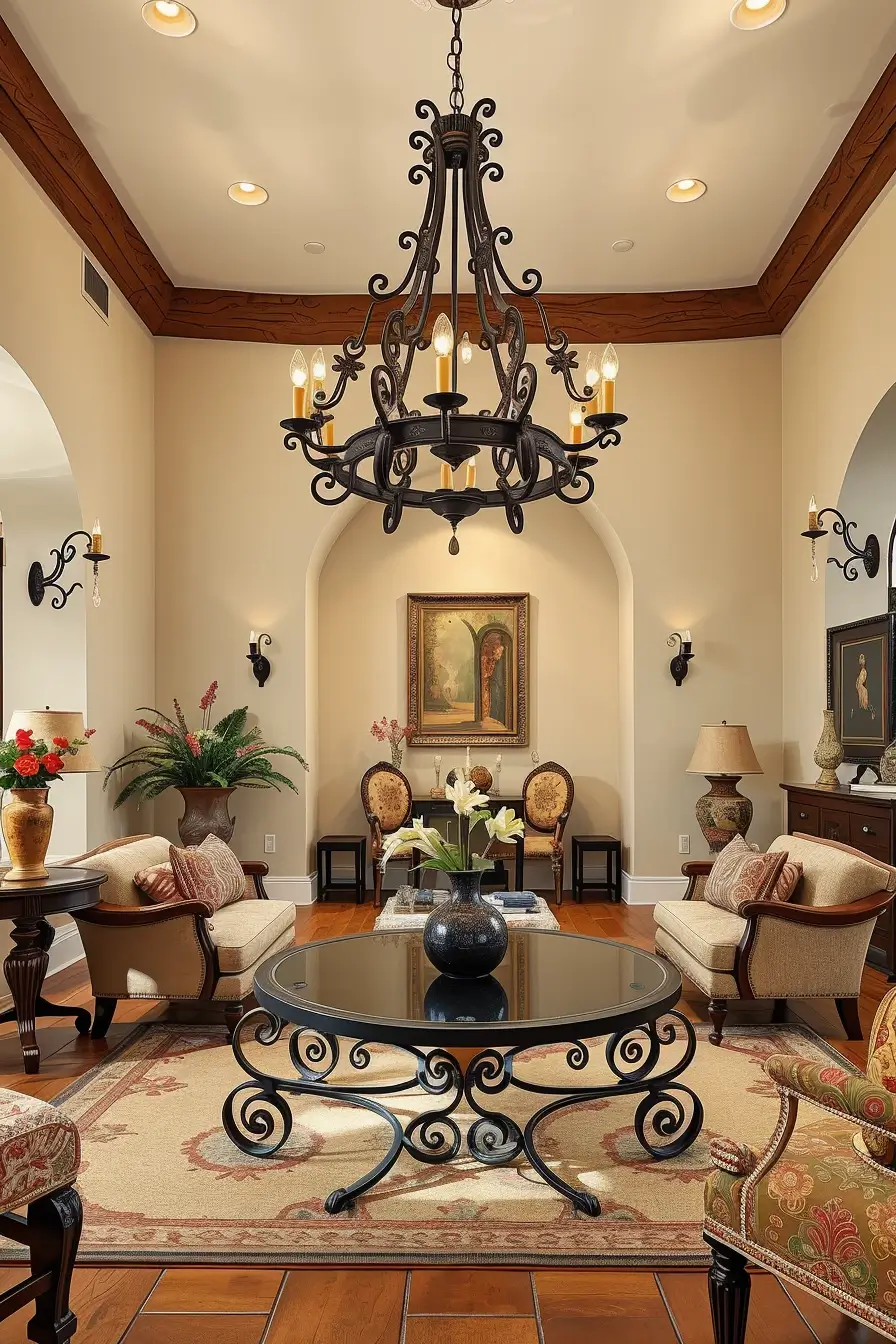
One of your dreams might be to transform your living room into an area that replicates southern European calmness. Your interest currently lies in discovering methods that combine natural elements and suntouched tones with contemporary living spaces. This article presents the most attractive Mediterranean living room concepts along with practical guidance about implementing terracotta combined with whitewashed walls and natural wood elements in your home. These design concepts enable you to introduce Mediterranean charm through elegant and warm elements regardless of your redesign scope.
Embracing Warm Earth Tones For A Sun-Kissed Look
The introduction of authentic Mediterranean living rooms begins with selecting warm earth tones as the primary color palette. The sunlight-infused package of colors automatically transports our minds to a coastal European vacation. The natural landscapes of the Mediterranean find their perfect match in sandy beiges combined with burnt siennas and olive greens and muted terracotta shades. The multiple colors work as both calming elements for the eyes and functional partners with various textures and home furnishings.
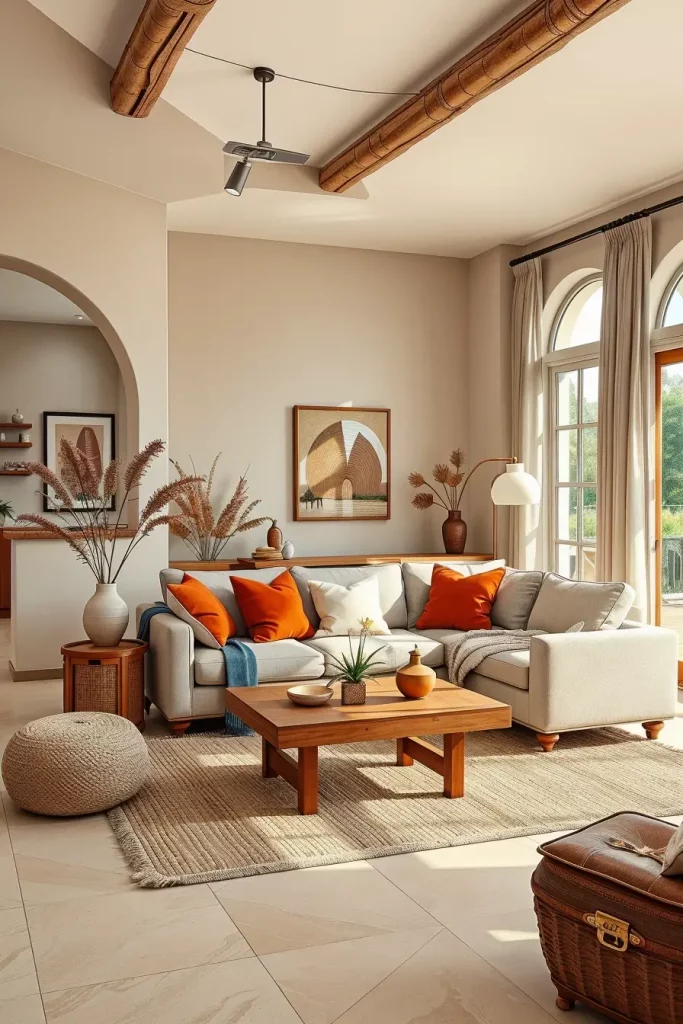
My choice of furniture upholstery consists of linen and cotton materials in off-white and cream tones which I pair with cushions and throws that display rich ochre and rust colors. The grounded ambiance of walnut along with reclaimed pine wooden tables maintains a low-profile as coffee tables. Jute and sisal textured rugs must be present to provide warmth and natural reinforcement through their textured appearance. The walls receive a perfect treatment with tan or clay-colored paint which pairs well with bronze-framed mirrors and carved wooden art pieces.

While creating spaces that match this look I strongly endorse the wall paint solutions from Benjamin Moore’s “Clay Beige” and Sherwin-Williams’ “Spiced Cider”. The chosen colors transmit daylight in a gentle manner which creates an open yet inviting atmosphere. Elle Decor identifies warm neutrals as a fundamental approach to developing Mediterranean indoor environments.
Handmade pottery pieces in terracotta and natural clay colors with hand-painted vases and bowls should be added to the side tables for finishing the section. Local artful textures act as the final detail that reflects the entire theme.
Incorporating Arched Doorways And Windows
The arched doorways and windows represent the most recognizable architectural features that appear in Mediterranean living rooms. These openings provide both graceful appearance and flow which counteract the standard rectangular room walls. Faux arches constructed using molding or trim produce a substantial transformation if you cannot fully remodel the existing architectural design.
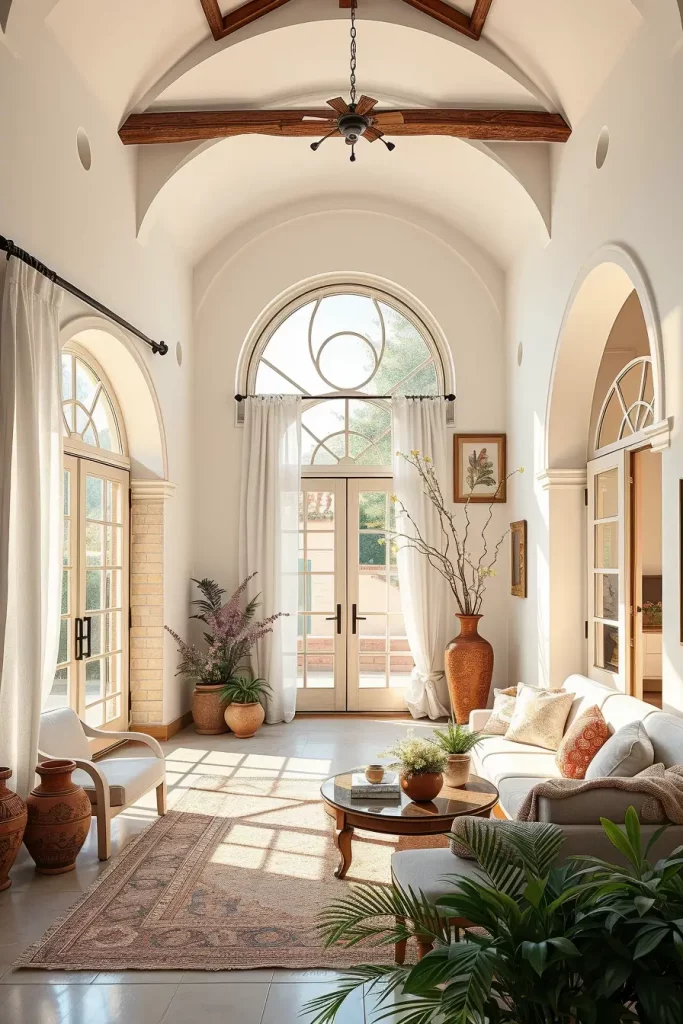
We installed an arched mirror above a console table as a window simulation which transformed the room lines into a softer appearance. White linen sheer curtains mounted on wrought iron rods create a romantic atmosphere that allows sunlight to pass through the windows. I design tall arched alcoves within walls to display ceramics and books as well as Mediterranean urns.
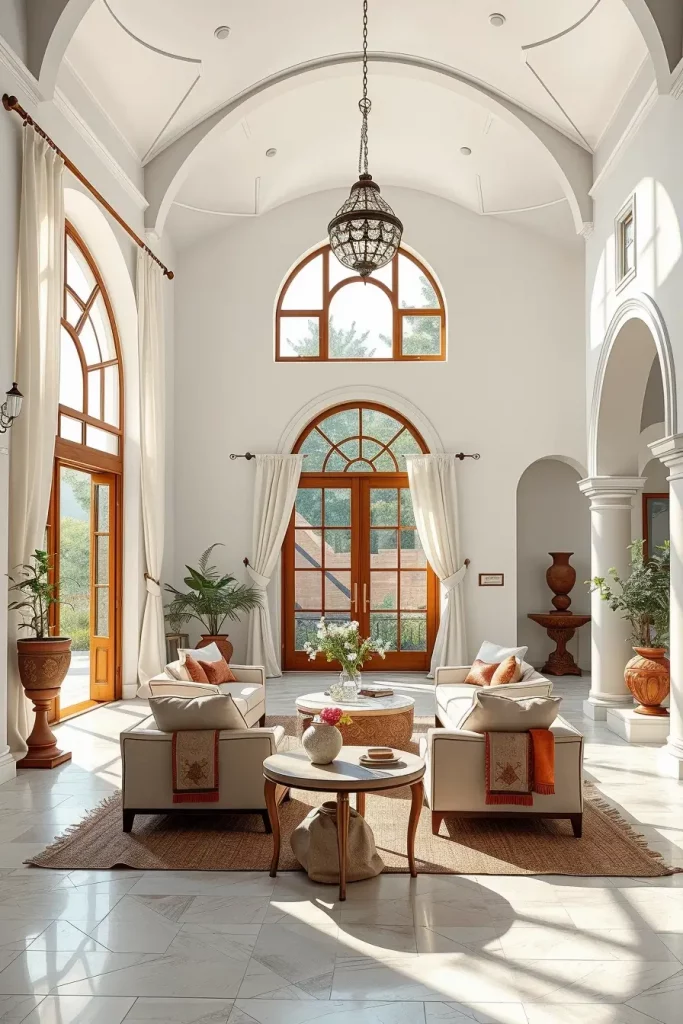
To me arches produce a storytelling effect which allows your vision to move between spaces while promoting an impression of expanded openness. The HGTV designers designate arches as essential elements that distinguish historical Mediterranean residences because they provide both continuous visibility and traditional Mediterranean architectural appeal.
One architectural mirror with an arched top should be included in the section if full window installations are not feasible. The basic elements bring equivalent design impact to the space while eliminating the need for architectural modifications.
Wrought Iron Details To Add Authentic Charm
Designing with Mediterranean living room ideas requires me to always incorporate wrought iron details. This material functions as an essential component because of its raw strength and artistic flaws. Room spaces gain immediate focus when you introduce wrought iron elements because these objects both establish grounding power and deliver traditional artistic details and historical heritage. The architectural element appears commonly in traditional Spanish and southern Italian villas as it creates framework without dominating delicate visual elements.
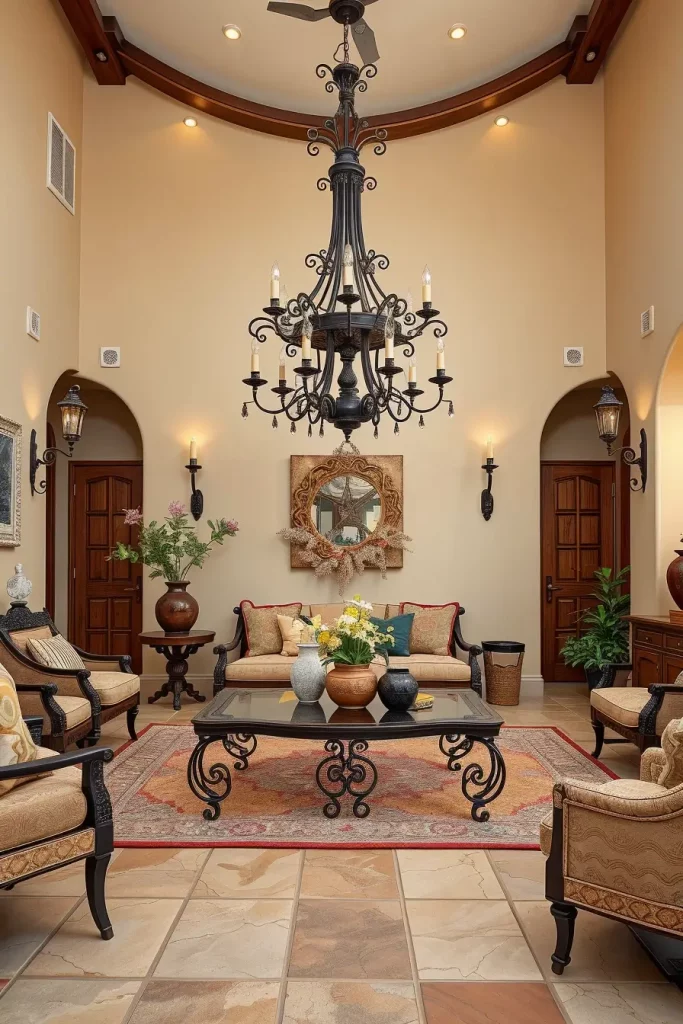
The handcrafted appearance of interiors comes from iron curtain rods together with scrolling iron coffee table bases and decorative wall sconces. My choice of decorative lighting and wall decor usually includes antique-finished metalwork and detailed iron latticework pieces. Blackened iron fireplace screens and stair railings take center stage when properly matched with other elements.
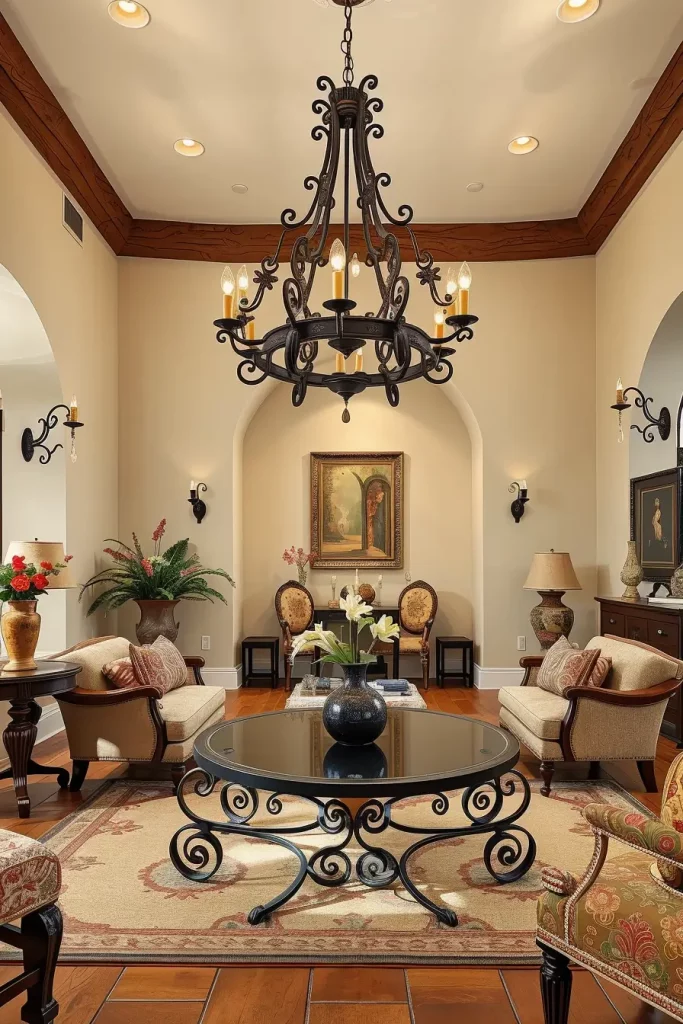
Wrought iron serves as my preferred element which controls the warmth between Mediterranean design elements that use soft materials. The combination of iron and rustic wood and soft textiles creates an everlasting lived-in atmosphere according to Architectural Digest. The strategy involves achieving unity while maintaining contrast at the same time.
A wrought iron chandelier or candelabra with faux candle bulbs should be added to complete the space when they are absent. The decorative element unifies all room elements while adding height and sophistication to the space.
Terracotta Accents For A Rustic Mediterranean Feel
Any Mediterranean living room requires terracotta accents to achieve its rustic grounded character. The elements feature natural warmth from earth exposure to sunlight which matches perfectly against antique artifacts and contemporary elements. I incorporate terracotta elements in many forms including pots and tiles and sculptures and painted walls because they represent the traditional Mediterranean craftsmanship.

My choice of Mediterranean decor includes large terracotta planters containing olive or fig trees or alcove-placed clay urns and stacked tile coasters for side tables. Matte terracotta tiles with white grout serve as both authentic and textural flooring material. A console table receives visual appeal through mismatched terracotta vessels that cost little.
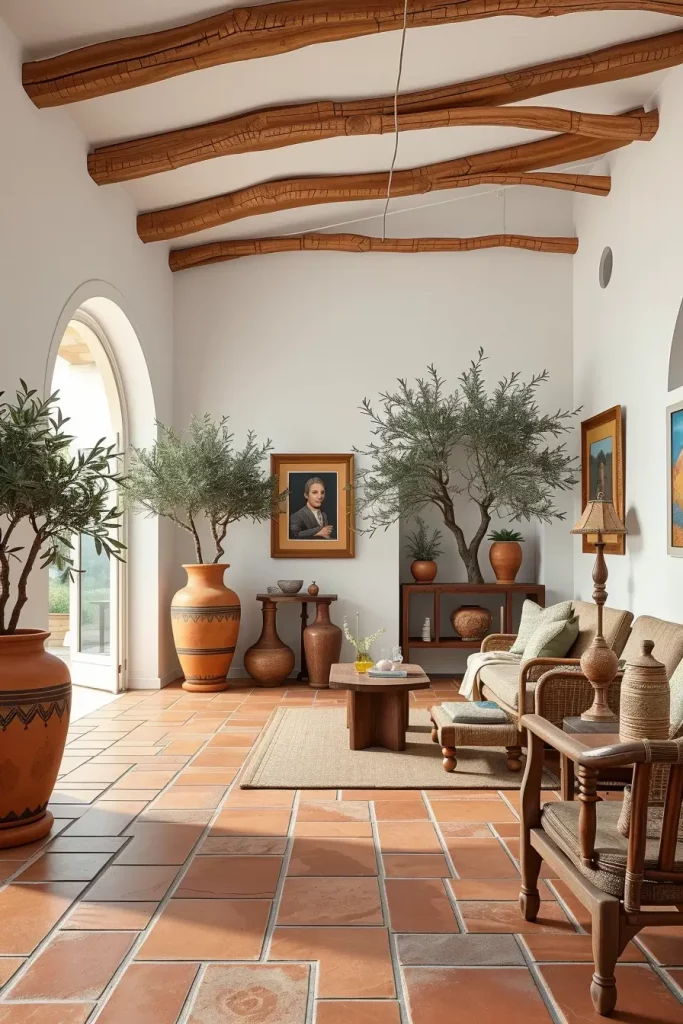
Homes in Andalusia and Sicily serve as my main inspiration because they integrate terracotta elements both for decoration and practical purposes. Domino Magazine advises that a couple of substantial terracotta objects will be more impactful than numerous small ones because they add depth and maturity to the room narrative.
The fireplace area would benefit from Moroccan-style terracotta tiles that could be used as wall accents or a coffee table inlay. These elements introduce vividness and worldwide appeal to the space.
Whitewashed Walls To Reflect Coastal Light
The coastal essence of Mediterranean living room ideas finds its perfect expression through walls that receive a whitewashed finish. The traditional whitewashed walls instantly transform all spaces into inviting airy and expansive areas. My preferred choice for walls includes limewash together with matte white paint because they create textural effects while adjusting incoming sunlight. The objective stands beyond flawless execution because organic movement and softness represent the main targets.
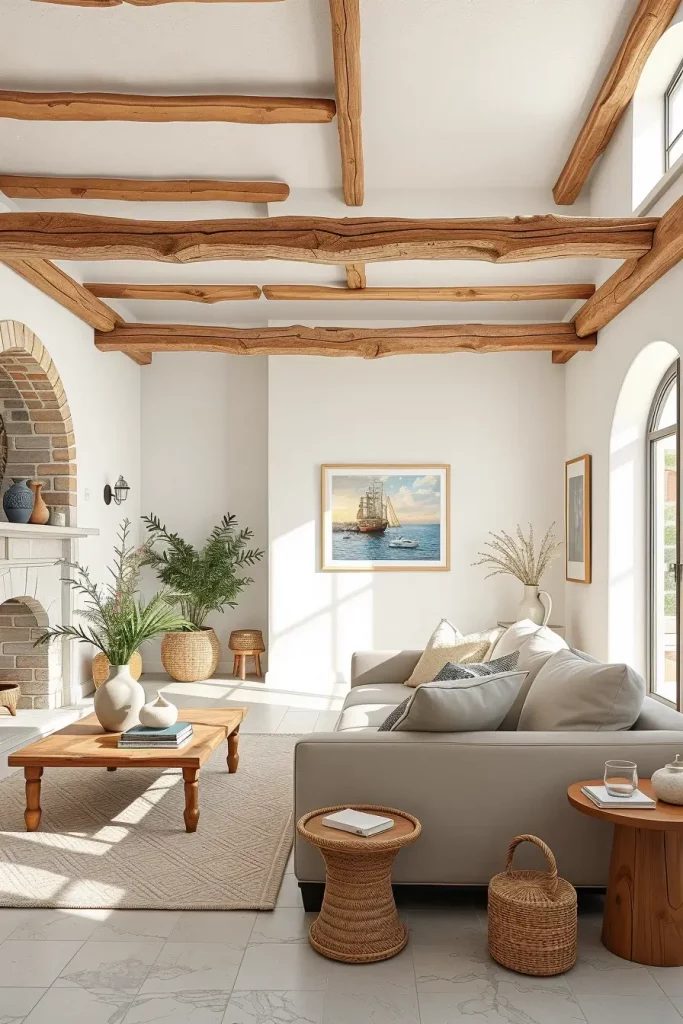
White-washed walls set the foundation as a blank background which creates space for earthy decor accessories along with bold textiles or darker furniture elements to become prominent. My projects use white walls together with wooden beam exposure and colorful ceramic decorations to achieve equilibrium. The technique transforms tight spaces into expansive and peaceful areas regardless of their actual size.
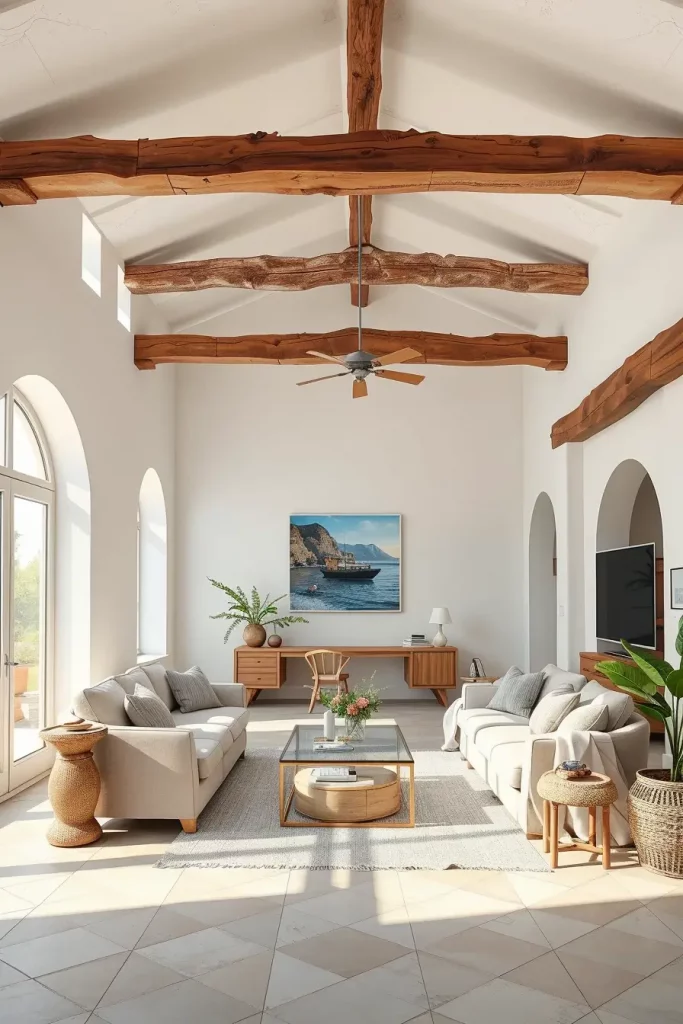
I have found that lime-based paint from Portola Paints produces a soft chalky finish which replicates the appearance of Mediterranean historical interiors. The wall treatment described by House Beautiful creates a grounded yet airy effect which matches the essential characteristics of this style.
The room lacks artistic elements as its main deficiency. The room would benefit from oil landscape paintings and Mediterranean sea pictures displayed in rustic wooden frames. The walls serve to enhance both the beachy atmosphere and the sea-inspired feelings of the room.
Natural Wood Beams To Define The Ceiling
Mediterranean living rooms achieve their highest visual impact through the installation of natural wood beams. The architectural elements create ceiling frames which generate a cozy and grandiose space atmosphere. Decorative and structural beams integrate an energetic old-world charm and dimensional pattern to the ceiling space.
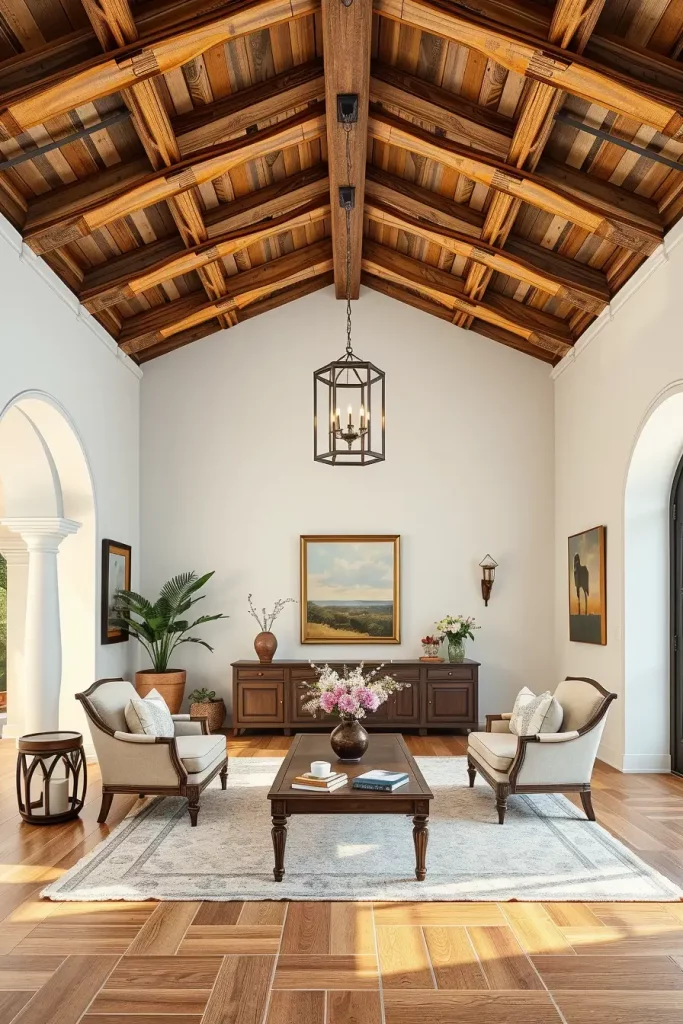
My preferred ceiling materials for practice include oak and chestnut wood which are either reclaimed or lightly stained. Exposure of beams creates a magnificent visual statement when the space combines whitewashed walls with gentle illumination. Plaster and stucco ceilings create an excellent combination when paired with beams to achieve a sophisticated rustic effect. I install pendant lights between beams to enhance the atmosphere.
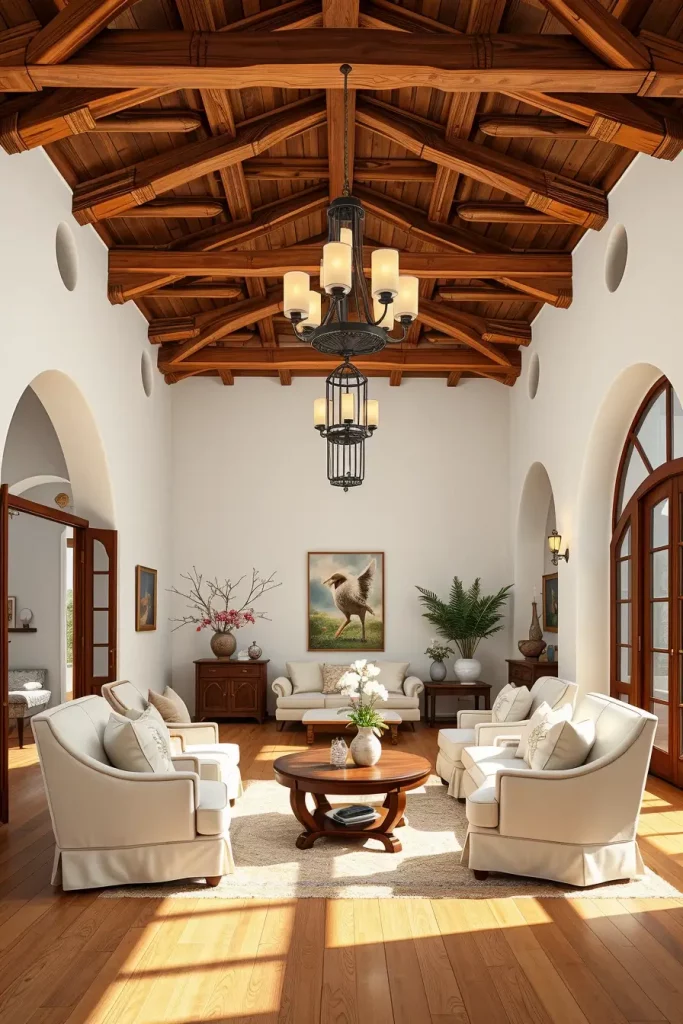
The application of ceiling beams transforms any living space whether it is big or small. Southern Living explains that wooden beams serve dual purposes because they contribute to defining both spatial dimensions and visual movement. These elements work perfectly with hardwood floors together with rustic furniture.
To enhance the wooden beams I recommend using wax or light oil instead of varnish because this method will protect the wood while maintaining its natural texture. The market offers excellent faux structural beams which perfectly mimic authentic wooden beams.
Layering Textiles With Mediterranean Patterns
Mediterranean living rooms gain their distinctive charm from layered textiles which I use frequently to bring designs to life. The term textiles in this context includes cushions and curtains as well as throws and poufs and area rugs which can display ikat and kilim and suzani and Mediterranean mosaic patterns. This area reveals the true character of the space.
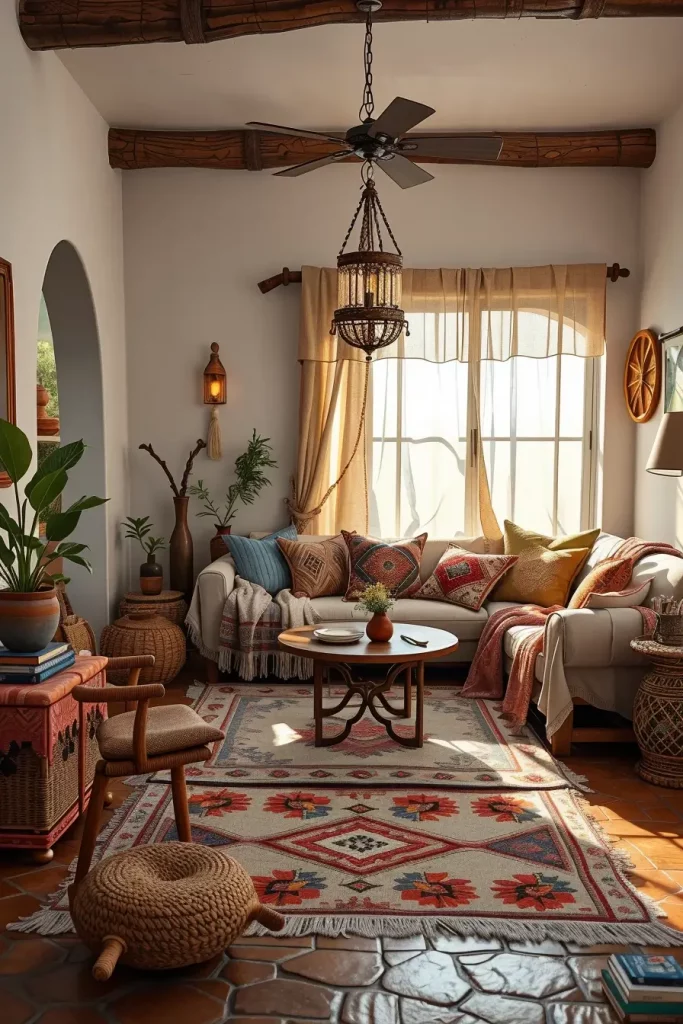
My design process starts with a cotton or linen slipcover sofa followed by the introduction of accents in indigo with terracotta and mustard and azure. The overall look is unified by Turkish print and Greek key patterned pillows together with rugs that bring North African design elements and sheer linen drapes. Tassels and embroidery should not be avoided because they create an artisanal charm.
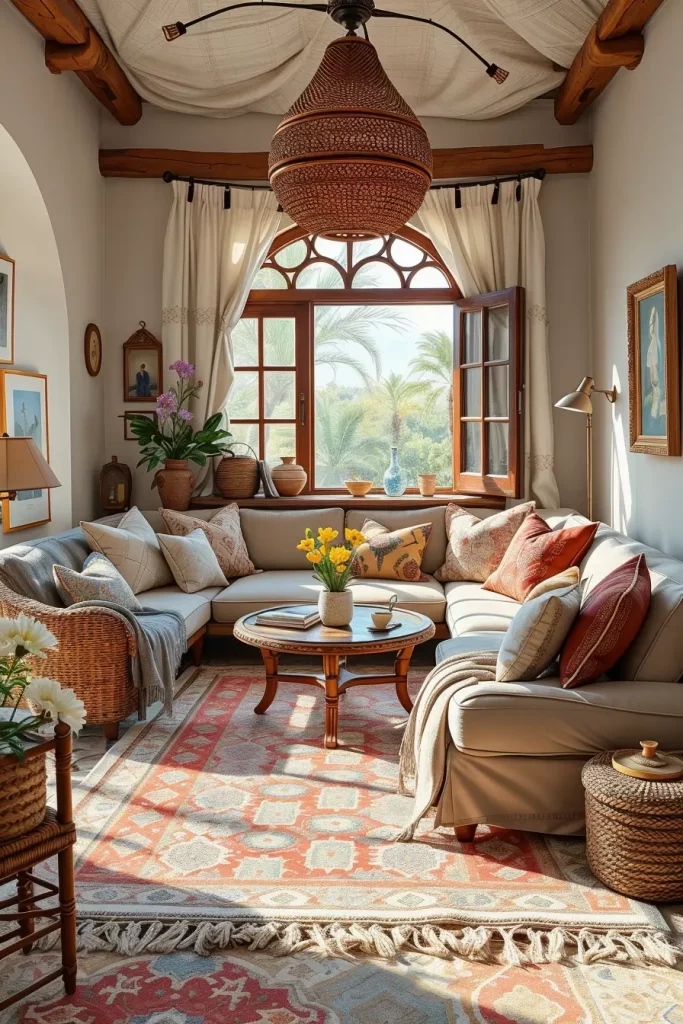
The practical value of textiles represents my viewpoint. Textiles enable easy alterations between different seasons which results in a dynamic room environment. Elle Decor indicates that adding multiple patterned fabrics in deep Mediterranean color combinations will give neutral or bare rooms both evocative energy and personal narratives.
The section would reach its peak with the addition of at least one authentic handmade textile such as a Moroccan throw or Greek woven cushion. Handmade textiles function as the elements which transform a styled space into one evocative of soulfulness.
Stone Fireplace As A Timeless Focal Point
The stone fireplace stands as one of the defining features which makes a Mediterranean living room instantly recognizable. The stone fireplace functions both as heating system and as an architectural element which creates a feeling of traditional European spaces. I always choose natural stone materials including limestone along with travertine and fieldstone with rough surfaces that create depth and authentic charm during my design process.
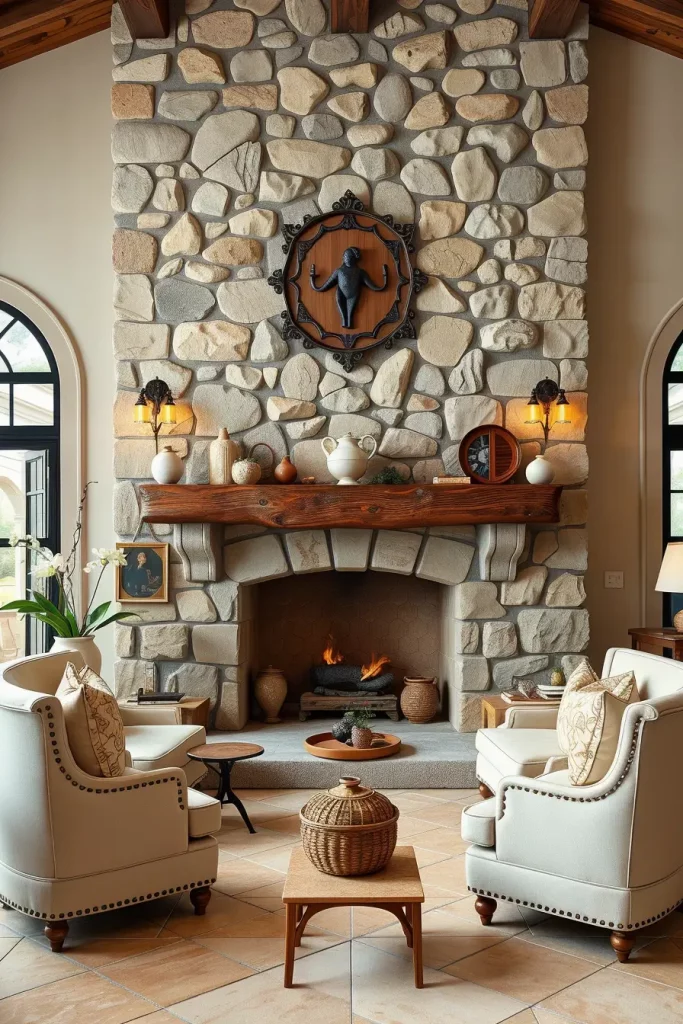
The fireplace becomes the central point of the room when I arrange seating areas to surround it. The linen-upholstered armchairs with deep seats and tufted ottoman together with rustic wooden mantelpiece create visual focus on the hearth. The mantel gets its dramatic touch from my installation of wrought iron candle holders and Moroccan lanterns. Rustic charm gets enhanced through the use of firewood baskets and antique fireplace tools.
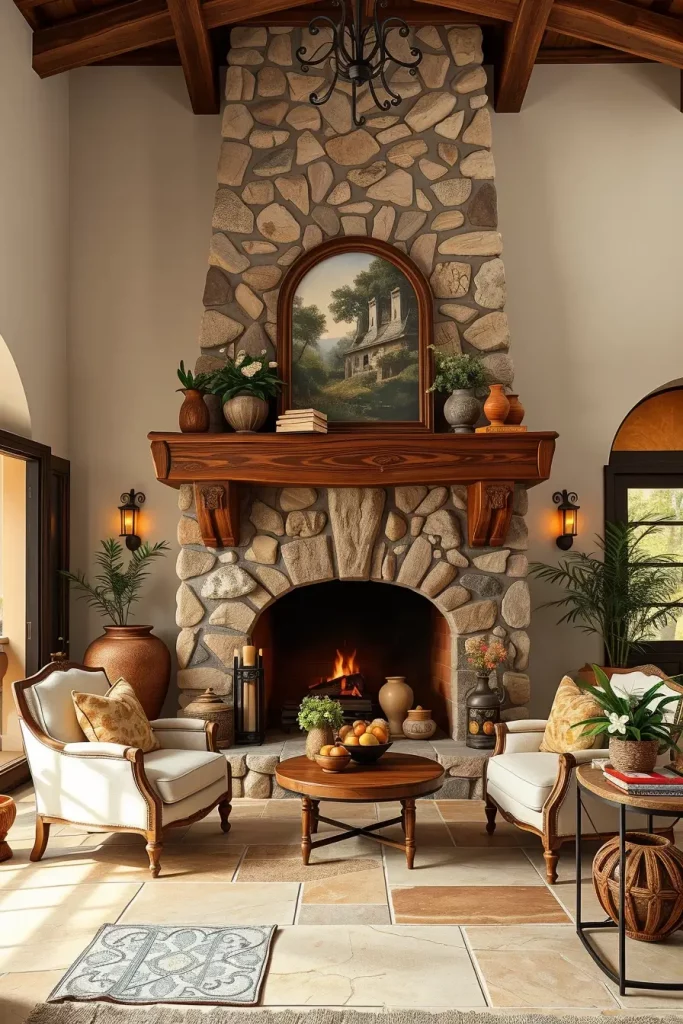
The fireplace serves as an ideal surface to display seasonal decorations according to my viewpoint. According to Better Homes & Gardens one should adorn the mantel with light garlands and Mediterranean pottery to create visual appeal that lasts all year. A contemporary stone fireplace can be transformed into modern minimalistic design through reinterpretation.
Built-in ceramic vase niches and Mediterranean art display areas should be considered for this concept. The component transforms from a basic heating device into a vital visual component.
Using Ceramic Tiles For Bold Mediterranean Flair
The essential element of Mediterranean design includes ceramic tiles which should always be present in living room areas. The creative application of these elements enables the addition of colorful craftsmanship that enhances the space. My preferred way to use tiles includes decorating coffee tables and stair risers as well as fireplace surrounds and wall panels behind shelving units.
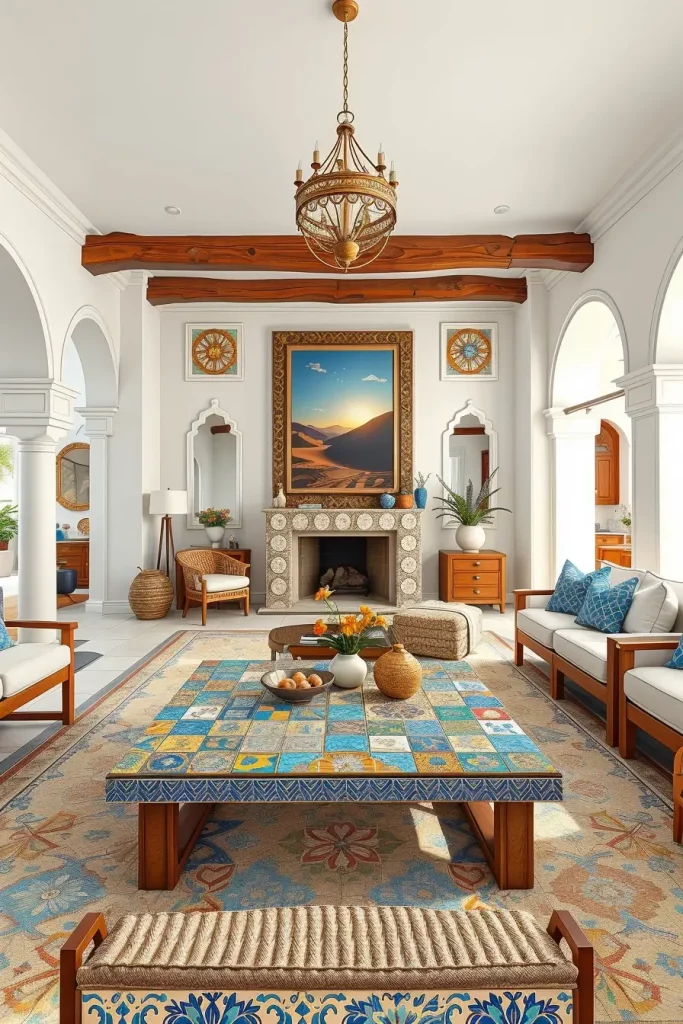
I select hand-painted tiles in classic blue and white together with emerald green and sun-drenched saffron colors. Spanish Moroccan and Portuguese tile patterns succeed in any setting especially when they include floral or geometric designs. The combination of contemporary furnishings with strong tile accents has worked out well for me because it stops the room from appearing traditional.
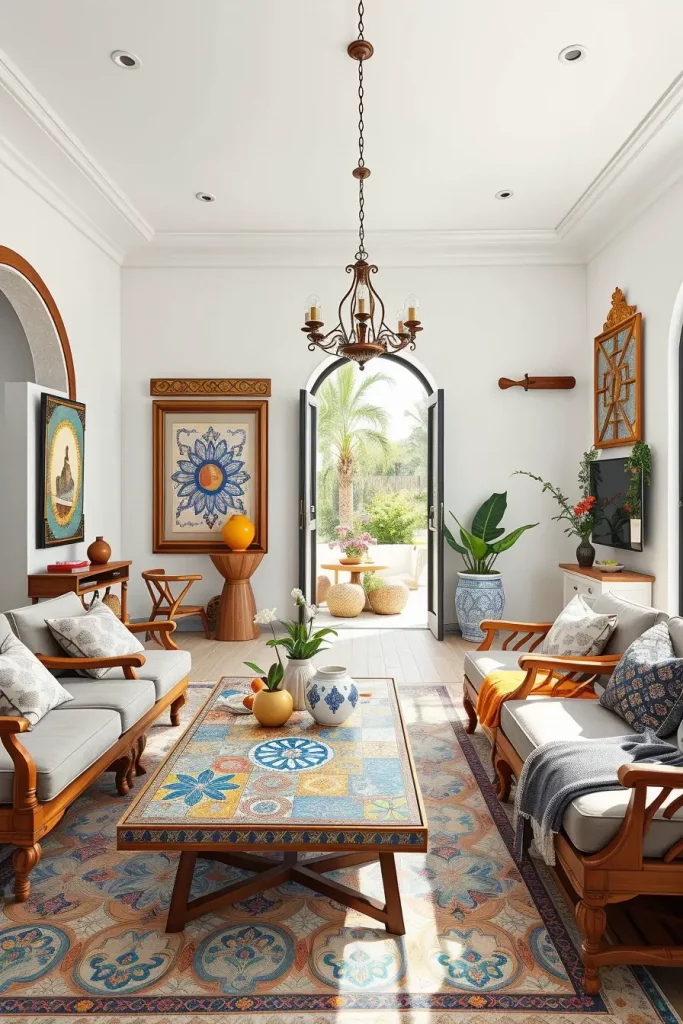
The expert designers at Architectural Digest explain how Mediterranean tiles provide artistic functionality by resisting moisture while changing the visual appearance of each space. When limited to just one wall as a feature element tile usage creates a stronger visual impact than when applied throughout the whole space.
The room would benefit from additional tile integration through a console table or fireplace bench to enhance its cultural appeal.
Adding Olive And Citrus Trees Indoors
Placing olive and citrus trees within the living room creates an instant Mediterranean countryside atmosphere in your home. The decorative plants serve two purposes by cleaning the air while simultaneously creating a natural connection to the environment. I keep a large terracotta container outside the window to place my potted olive tree which receives natural sunlight. The plant creates an elegant atmosphere which requires minimal care.
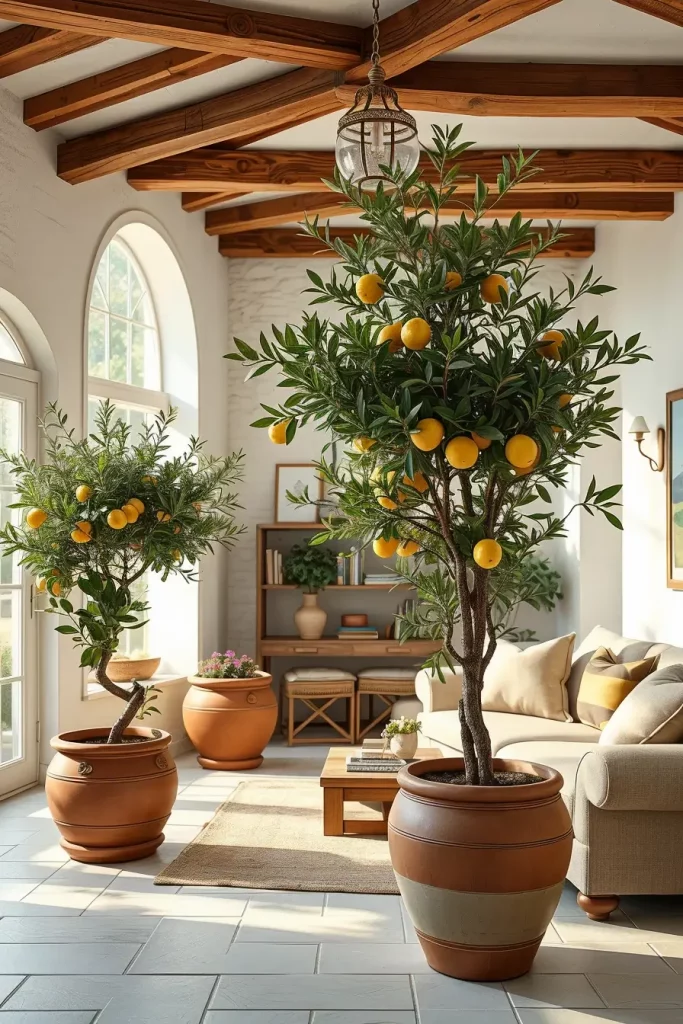
Olive trees featuring their silvery-green foliage create a perfect match with neutral colors and wrought iron decorative elements. Lemon trees introduce energetic brightness through their vibrant nature. A living sculpture emerges from placing a Meyer lemon tree in a glazed ceramic planter either by the fireplace or at the living room entry. The planted trees introduce both visual depth and physical movement while delivering sensory experiences to the room.
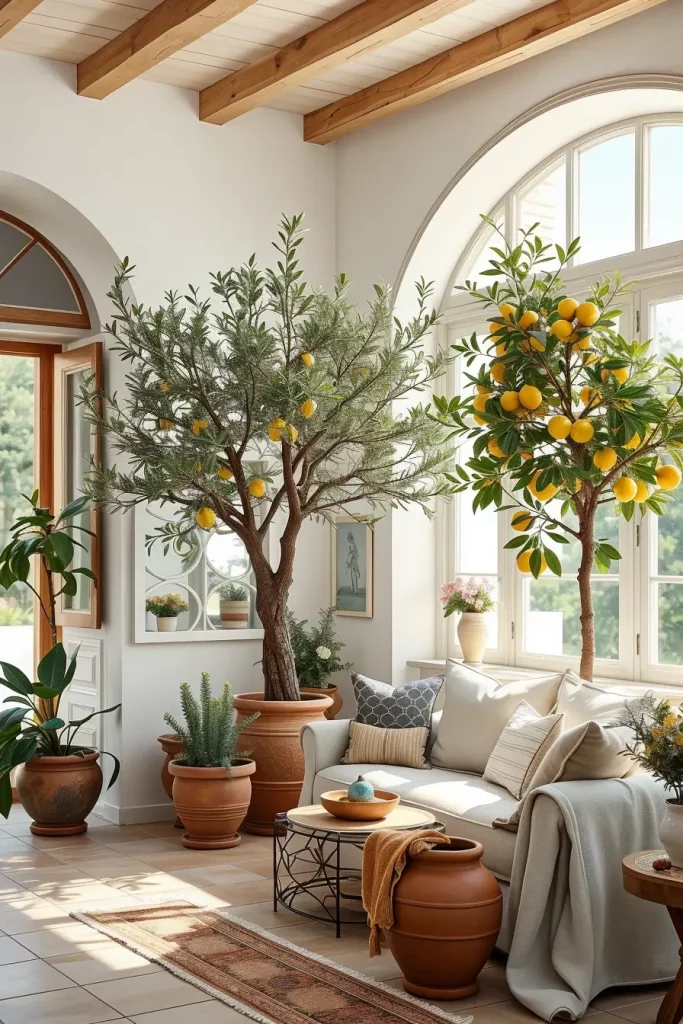
The living space gains its energy from the plants which I find very appealing. Southern Living indicates Mediterranean-style interiors succeed when they incorporate “living accents” which enhance organic materials together with natural color schemes. My observation shows that living room spaces become more welcoming and inspiring when clients place plants inside.
I would enhance this idea by planting rosemary and lavender underplantings in the same containers. The Mediterranean-inspired herbs introduce both Mediterranean spirit and delicate scents along with textural elements.
Open Layout Living Spaces With Seamless Flow
The open floor plan characterizes Mediterranean interior style because it unites the space between living rooms and dining areas along with kitchens. The free space design elements create a pleasant and social atmosphere which suits both hosting guests and spending time with loved ones. Open-plan spaces require me to eliminate all visual obstacles and use broad furniture pieces while designing sightlines that remain unblocked.
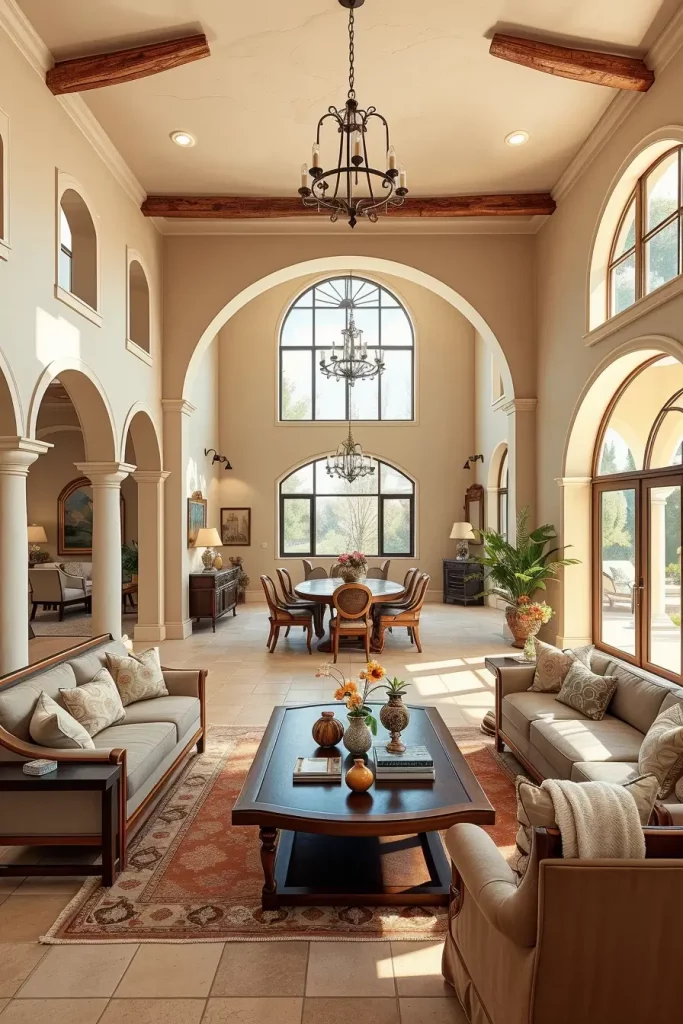
Open spaces receive their divisions through area rugs and arched entryways together with beams over the living area and smooth ceilings over the dining space. The same palette of earth colors along with natural elements unites the whole space. Furniture arrangement through console tables and reverse-facing sofas offers gentle guidance between open areas.
Open physical designs give homeowners impressive adaptability in their homes. Veranda Magazine explains that Mediterranean interiors function best when they allow “breathing” which enables free movement of light and energy throughout the space. Large windows and patios function well in such spaces because they enable seamless visual integration into the living area.
The section would benefit from the addition of folding glass doors or arched indoor windows which allow rooms to connect. The architectural depth will emerge from this physical open space.
Embracing Blue And White Color Schemes
Many Mediterranean living room ideas rely on the fundamental blue and white color scheme. The color combination unites the fresh oceanic feel of Greece with the relaxed Italian country charm. I implement this color pairing to establish an inviting atmosphere in my designs which typically appears against white surfaces and limestone surfaces.
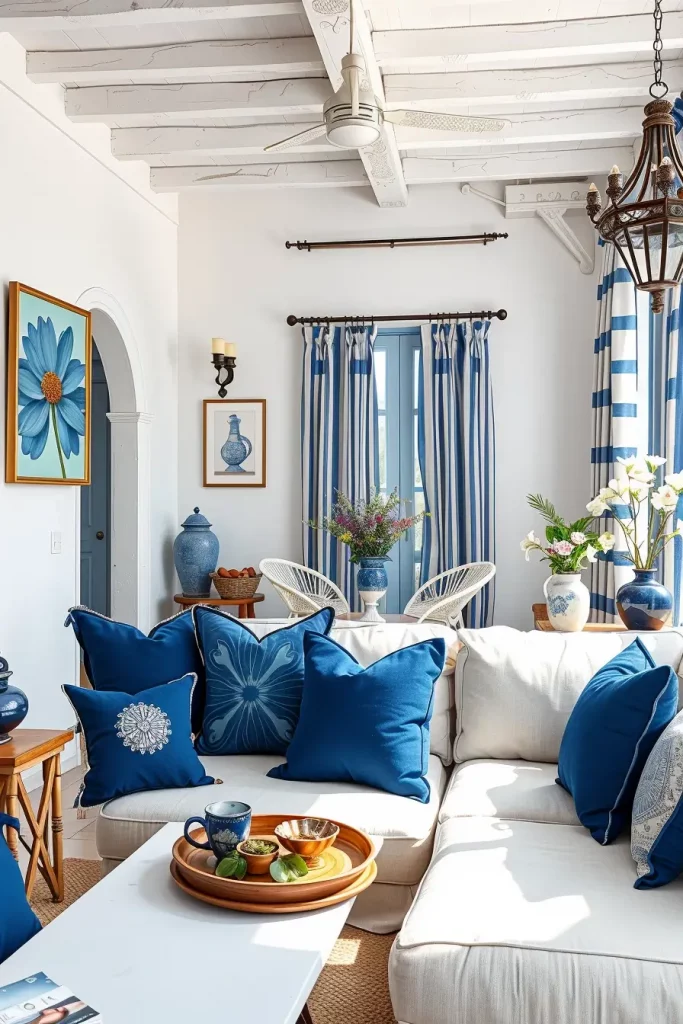
The blue-and-white scheme works through basic applications from blue patterned throw pillows resting on white sofas to complete blue-and-white tiled accent walls. My design approach includes matching light linen sofas with cobalt vases and indigo poufs and navy-striped drapes. The completion of this color scheme requires blue glass elements and Mediterranean ceramics. White and deep blue create an energetic room atmosphere that never fails to energize.
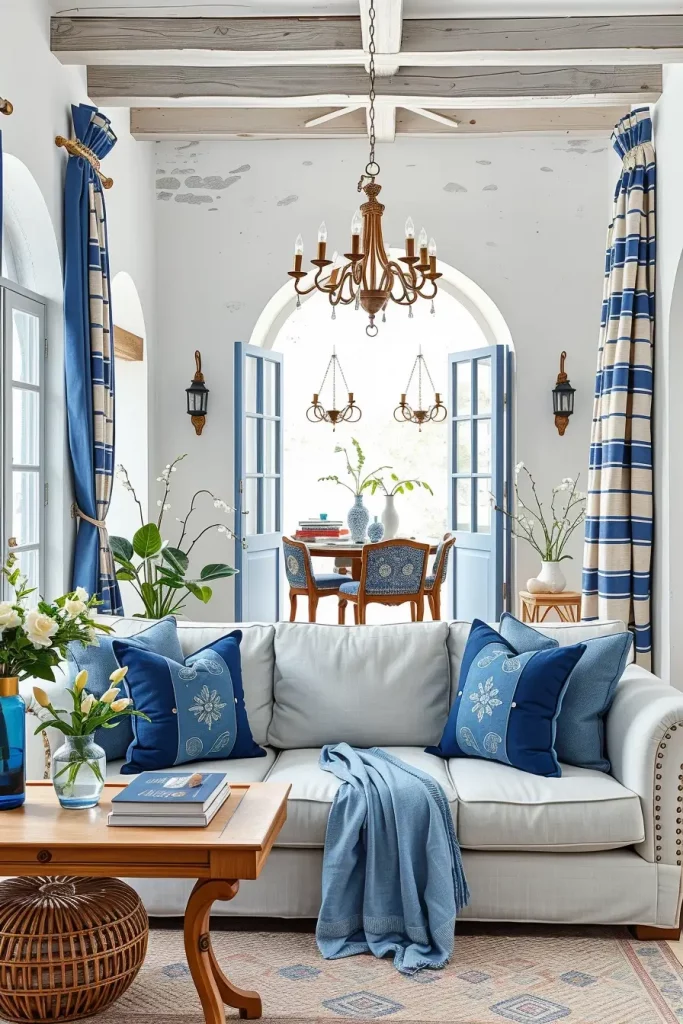
I have always appreciated how this color combination presents itself with refined beauty. Coastal Living explains that this color combination creates a sense of relaxation and refinement when it combines with wood and stone elements. The natural light in such spaces intensifies the clean appearance of these colors.
White fabrics in textured patterns such as waffle-weave throws and bouclé cushions should be considered as final touches to achieve dimension along with softness while upholding the color scheme.
Rustic Furniture With A Weathered Finish
Rustic furniture pieces serve as the base of Mediterranean living rooms because they present an aged and handcrafted appearance with abundant character. My search focuses on coffee tables constructed from salvaged wood and sideboards that exhibit natural wear marks alongside chairs covered in burlap or rough linen materials. The furniture pieces embody the easy sophistication of rural dwellings located in Provence or Tuscany.
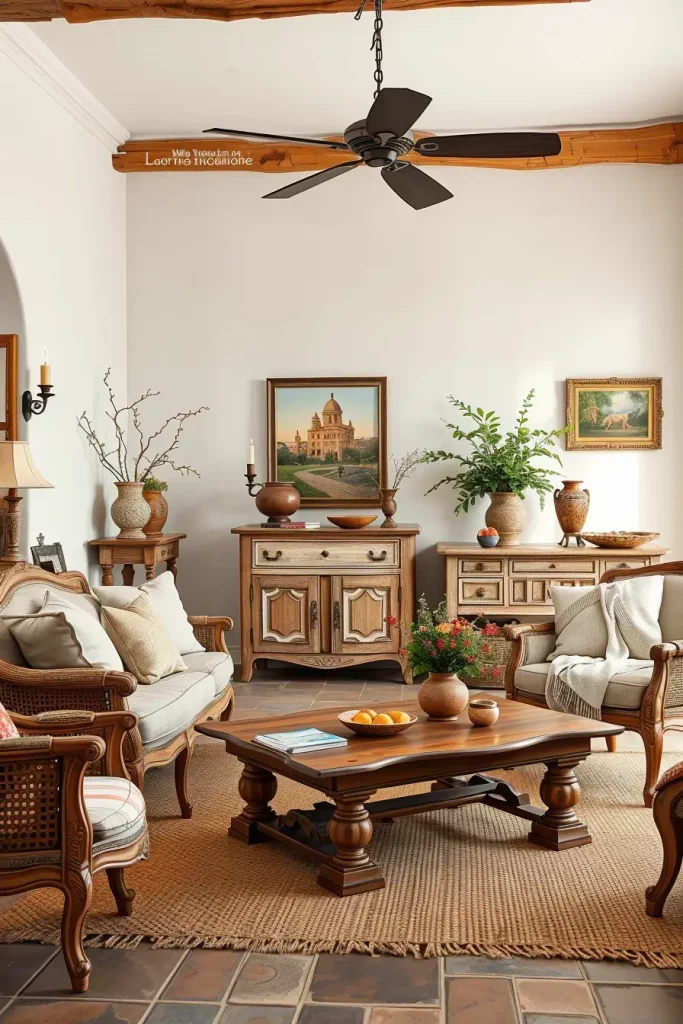
I always choose an ivory or beige sofa to surround my heavy wood coffee table with carved legs as my essential living room setup. The combination of aged patina furniture with ladder-back chairs or benches works best for me while matte finishes replace polished ones. Open shelves constructed from dark walnut timber or weathered oak materials create a rustic feel that matches better when they contain ceramic pieces and old books.
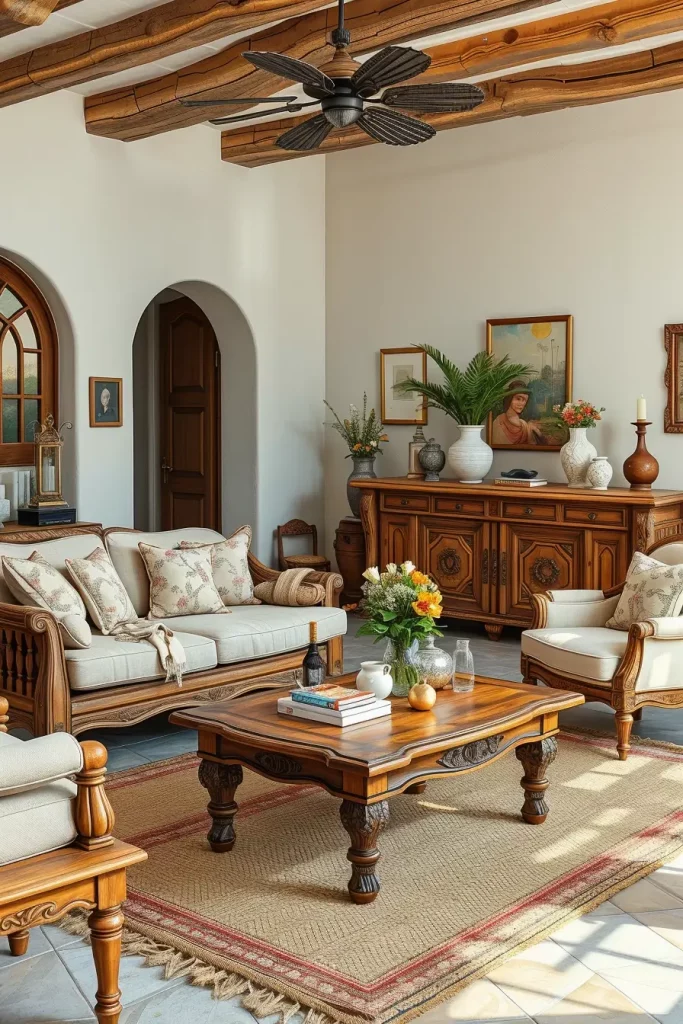
Rustic design does not require outdated elements in my view. House & Garden UK points out that aged finishes create storytelling elements which reduce the formal nature of Mediterranean rooms. The rustic design style creates equilibrium between elegant components including marble and tile and wrought iron.
The basic idea when starting from scratch involves selecting one rustic focal piece like a sideboard or table which serves as your reference point to construct the room design.
Using Lantern-Style Lighting Fixtures
The Mediterranean living room requires warm inviting handcrafted lighting which is why I consistently use lantern-style fixtures. The fixtures typically consist of aged materials like iron, bronze and brass which recreate the traditional Mediterranean town atmosphere. Lanterns serve as reading corner illumination when mounted on walls or they create table top illumination when suspended overhead.

Three types of lanterns exist with open-cage and frosted glass and pierced metal structures that produce distinct ambient lighting effects. My lighting choice consists of table lamps with linen shades which I use to create multiple layers that develop an inviting atmosphere. Candlestick-style bulbs inside lanterns create an enchanting atmosphere which modern LED panels cannot replicate.
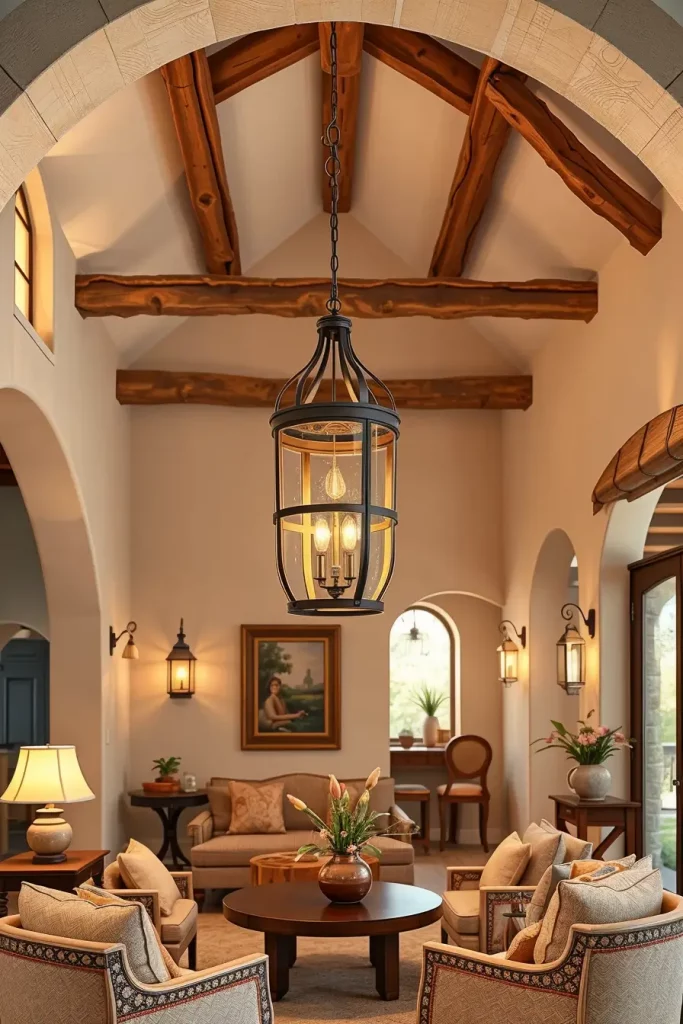
Lanterns become prominent visual elements in all my design projects. Lumens lighting experts indicate that Mediterranean lighting functions optimally when it creates room structure and tells a story. These fixtures function as both illumination devices and they become sculptural elements in the air.
A dimmer switch would be my one preference addition to the design. A dimmer control allows users to adjust the lantern’s brightness which shifts the atmosphere from daytime to nighttime at their will.
Mediterranean-Inspired Wall Murals And Art
A Mediterranean living room requires wall art for achieving its distinctive character. My initial artistic choice begins with large-scale paintings which depict coastal views or terracotta towns or olive tree landscapes. The Mediterranean visuals serve both decorative and transportive purposes because they recreate the sun-bathed rural Mediterranean environment. The purpose of wall art goes beyond color addition because it actively brings to life a specific lifestyle together with its associated mindset. Mural artworks create a setting while functioning as central elements that unite all room elements.

My choice of artwork usually consists of hand-painted mural canvases or framed pieces which feature a combination of earthy tones including terracotta, ocean blue and mustard yellow. An ideal wall position should be located above the main seating zone or on a prominent wall area. The authentic look can be achieved through the integration of tiled wall art panels. For those who wish to make a statement the fresco-inspired mural across a full wall provides an excellent choice. When using subdued decorations with these interior choices the resulting ambiance becomes sophisticated yet remains refined.
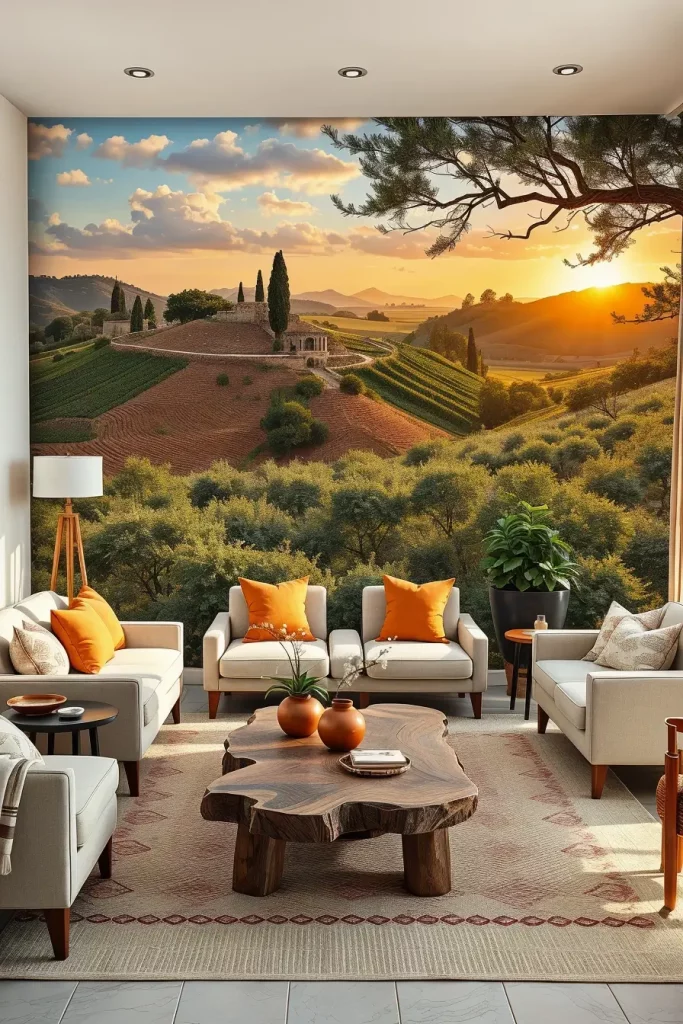
The visual storytelling element finishes and perfects the space according to my personal opinion. According to Architectural Digest building decorative murals within Mediterranean spaces enables homeowners to experience transportive relaxation within normal domestic environments. According to my opinion the use of murals enables you to experience the feeling of endless horizons within your living space.
The section can be enhanced by installing picture lights or sconces for artwork illumination and dimensional effects during nighttime.
Incorporating Mosaics In Decor Elements
The art of mosaic-making represents one of my strongest favorites when it comes to creating detailed decor in Mediterranean style living spaces. The addition of mosaic elements on side tables and coffee tables as well as decorative wall and floor inlays brings artisanal charm that remains elegant through time. These elements work exceptionally well to introduce soft textures with muted colors for those who want elegant artistic details.
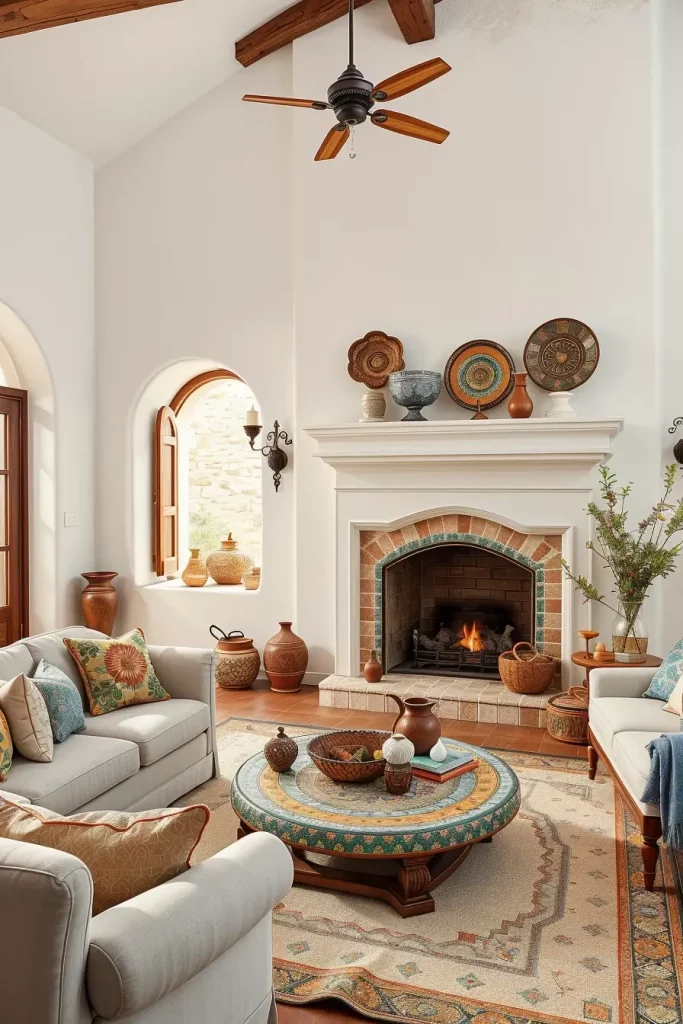
I prefer to work with blue white and terracotta-toned ceramic and glass mosaic tiles. Accents made from mirror frames and tabletops and mosaic bowls serve to highlight the room without becoming dominant. My approach includes incorporating mosaic details onto fireplace surrounds and niche areas because they create both homemade beauty and meaningful visual upgrades to the decor.
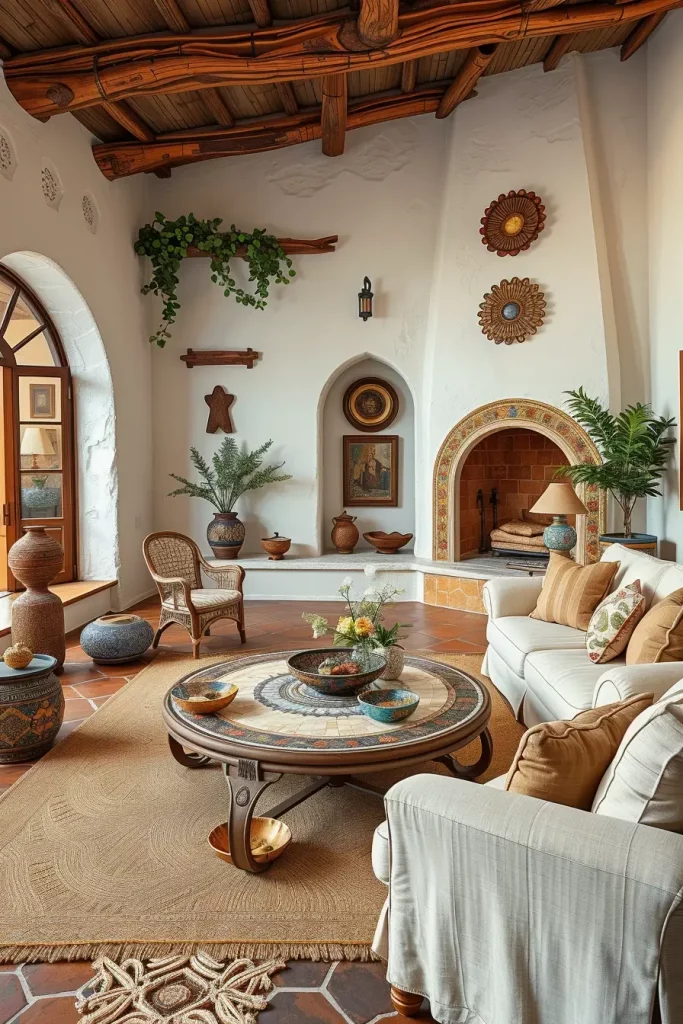
Elle Decor stands as my top inspirational source by advising people to pair ornate surfaces with smooth delicate furnishings. Mosaic design elements function best when they receive visual relief through the addition of plush sofas or creamy walls to prevent visual clutter.
A custom mosaic medallion placed as the central floor motif would enhance this design choice especially when your space features open-concept layout.
Arched Niches For Displaying Decor
Arched niches represent the Mediterranean essence perfectly while becoming an elegant indoor way to introduce this architectural detail. The recessed regions function as ideal display spaces for vases along with sculptures and books and candles. The decorative interior niches add dimensional interest to bare walls without the need for extensive construction work.

I prefer to build symmetrical wall niches which should be placed on both sides of fireplaces or running along central walls. The niches should receive either a darker wall paint color or stucco application to create texture. The interior of my niches typically holds pottery and antique lanterns or olive jars which serve to enrich the space with historical elements and place-specific ambience.
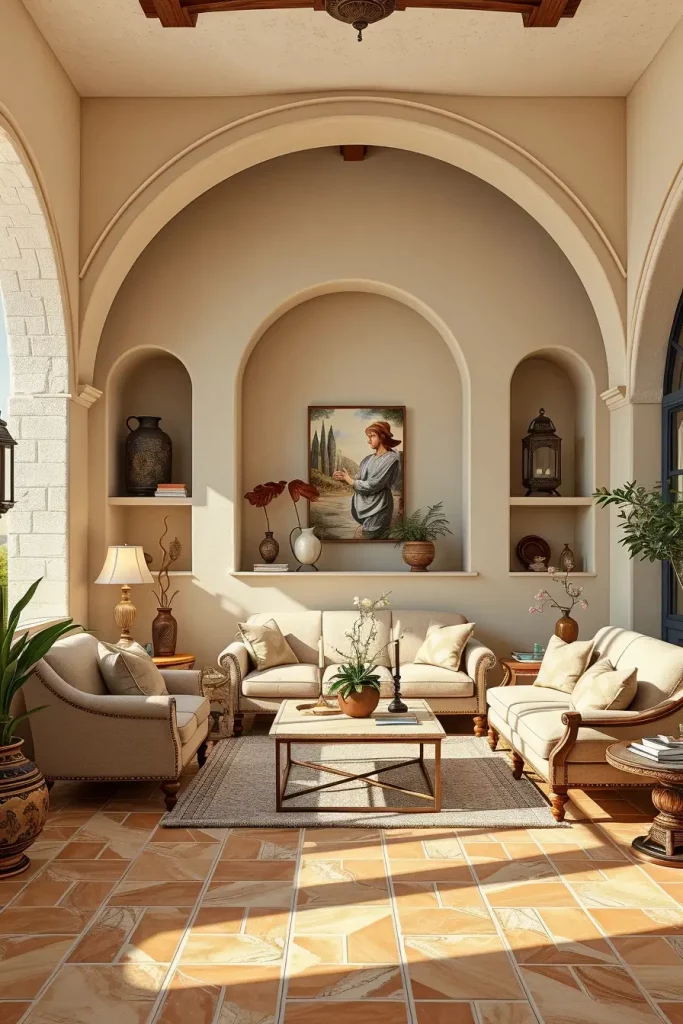
The implementation of these niches produces transformative effects on the entire space according to my personal professional experience. The Veranda magazine states that recessed nooks and arches create a permanent historical atmosphere. I wholeheartedly agree. janitors enhance any minimalist or Mediterranean design regardless of its basic architectural elements.
Soft spotlights positioned within the niches will illuminate their contents and generate evening illumination.
Coastal-Inspired Mediterranean Decor Touches
To create a relaxed Mediterranean atmosphere I incorporate coastal items which bring to mind Greek islands and Spanish beach towns. The decor includes woven baskets and driftwood pieces with pale sea-blue decorative elements. Such elements bring a cozy atmosphere that maintains thoughtfully selected decor.
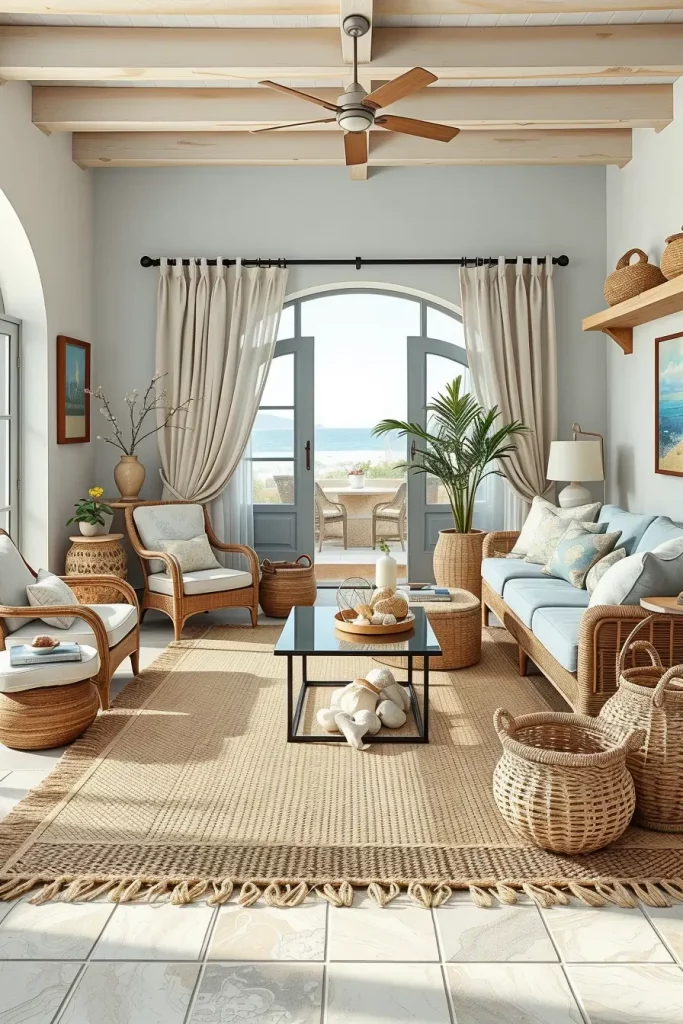
I use linen-covered cushions together with coral sculptures and ceramic seashells as decorative items on coffee tables and shelves. Large hurricane vases filled with sand and candles create an attractive decorative display. The theme comes together through natural woven floor textures which include jute and sisal rugs that also provide warmth.
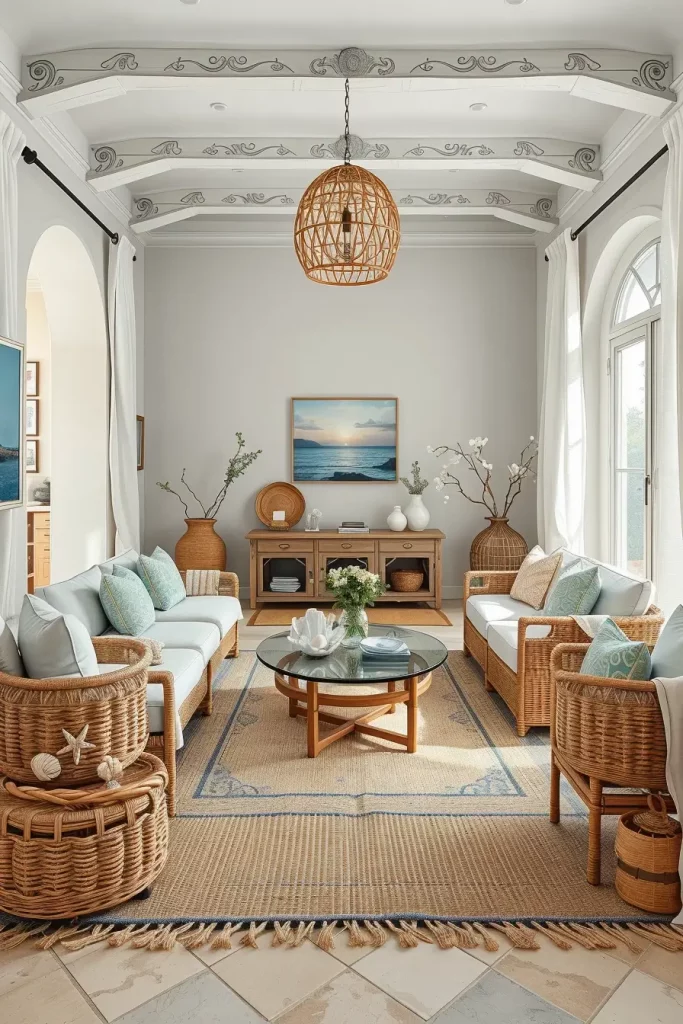
According to my experience people should balance delicate nautical design elements with care to avoid becoming mired in beach-house clichés. According to Coastal Living publications the best way to enhance architecture is through raw textures together with natural materials instead of crowding it.
The section can achieve greater elevation through the introduction of pale blue or sea-glass green curtains or throw blankets which bring peaceful color tones.
Stucco Walls And Textured Plaster Finishes
A distinctive feature of Mediterranean interior design consists of how homeowners treat their walls. Your best choice to create sun-weathered Mediterranean house appearance consists of stucco walls or textured plaster surfaces. The applied finishes generate visual interest that extends throughout neutral-colored surfaces.
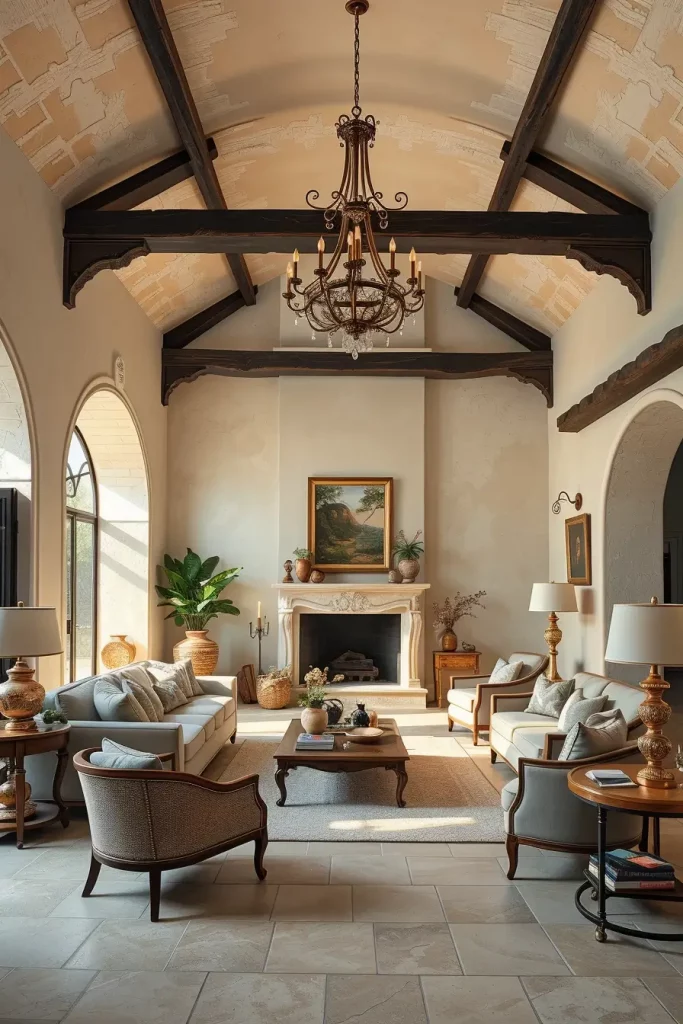
The wall finishes I select for my projects consist of lime plaster combined with Venetian plaster which results in a matte textured surface. The walls acquire a classic appearance through this treatment while the light creates gentle and refined reflections. The DIY solutions I propose include stucco-painted surfaces and pre-textured wallpaper options for those seeking affordable alternatives.
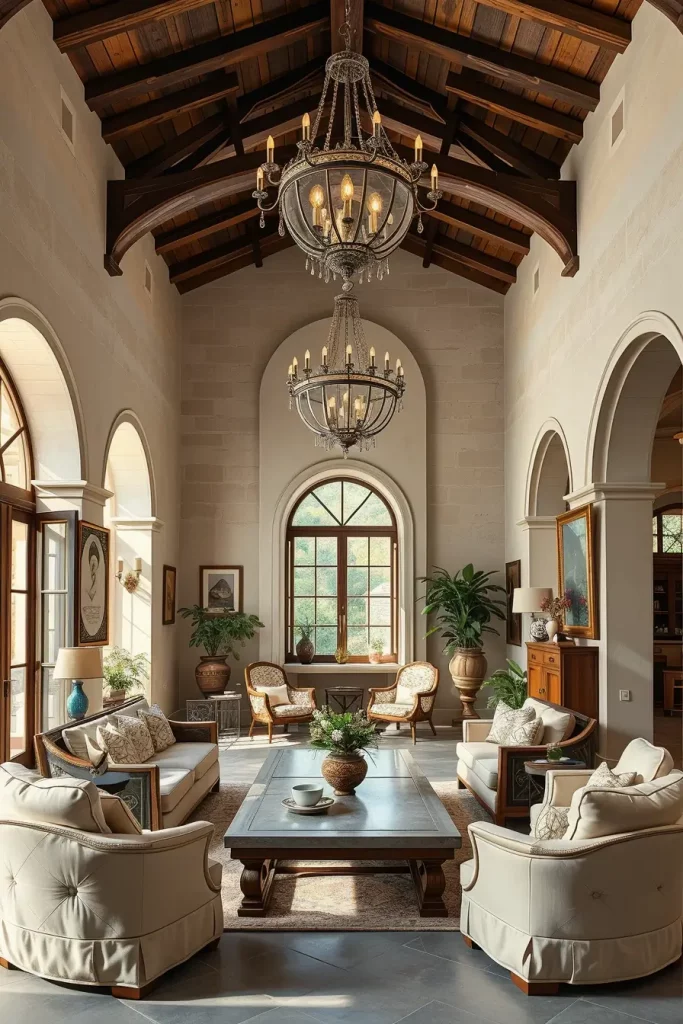
My experience with wall finishes shows that texturing walls makes them ideal for supporting rustic wood beams and iron light fixtures. Textured walls according to House Beautiful provide an authentic feeling and emotional depth to spaces that feel new or sterile. Very true to my eyes is the way spaces with old-world craftsmanship make every visitor feel welcomed through the warmth of such workmanship.
You can extend the textured appearance by applying it across ceilings or implement arched doorways to achieve continuous architectural design.
Low, Lounge-Worthy Mediterranean Sofas
Any Mediterranean-style living room needs comfortable seating which I prefer as low-profile lounge-worthy sofas. Wide deep-seated furniture pieces receive upholstery treatment with breathable materials such as cotton and linen. These seating options enable relaxed relaxation as well as family bonding and extended discussions.
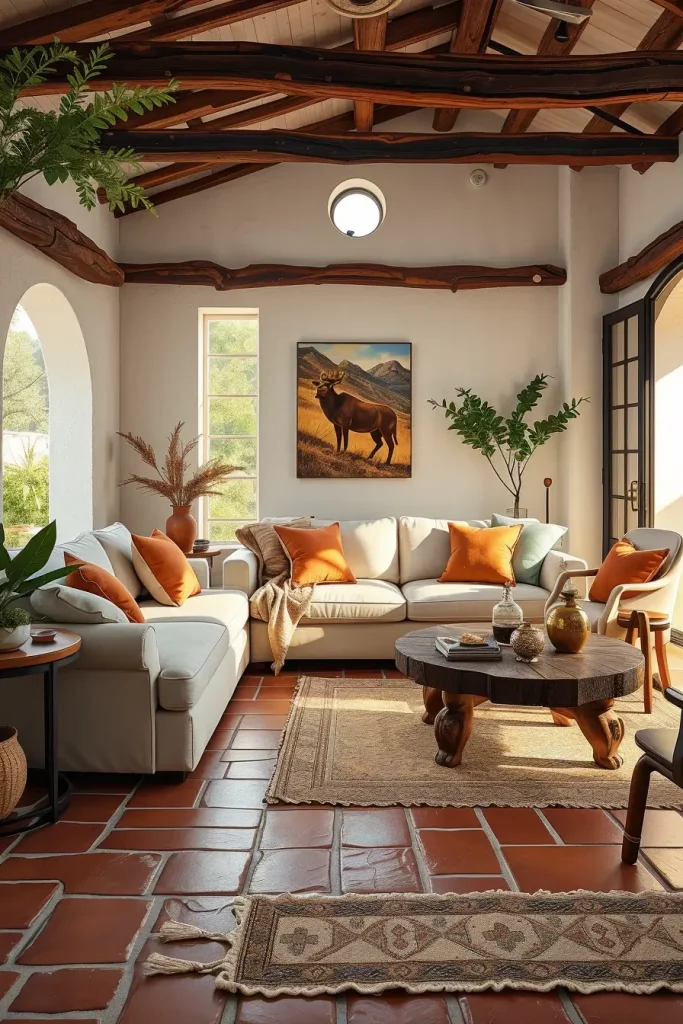
I typically choose sectionals without arms alongside modular seating that uses off-white or warm clay colors and sofas featuring wooden bases which are either exposed or made from natural materials. Large throw pillows in ochre and cobalt and muted red colors work perfectly with these pieces to create visual unity with surrounding decor.
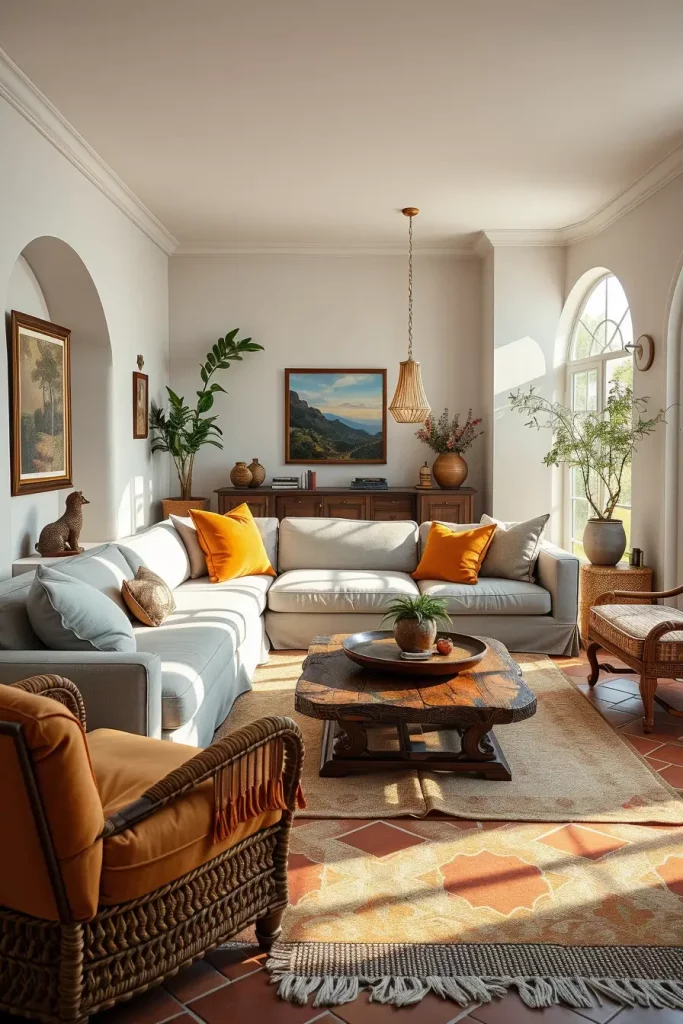
These sofas achieve a grounded luxurious atmosphere when they are used with terracotta tiles and patterned rugs. Dwell magazine advises selecting large sofas with linen upholstery to achieve a relaxed elegant appearance which I frequently recommend to clients who need both style and practicality.
You can achieve a layering effect by obtaining a low wooden coffee table which suits well with poufs or ottomans made from matching fabric.
Elegant Draperies With Lightweight Linen
Every Mediterranean living room requires elegant draperies made from lightweight linen to achieve completion. White cream and soft beige light flowing curtains serve as my preferred choice because they both reflect sunlight and create a soft touch to architectural elements. The curtains create a breeze effect through their smooth movements.
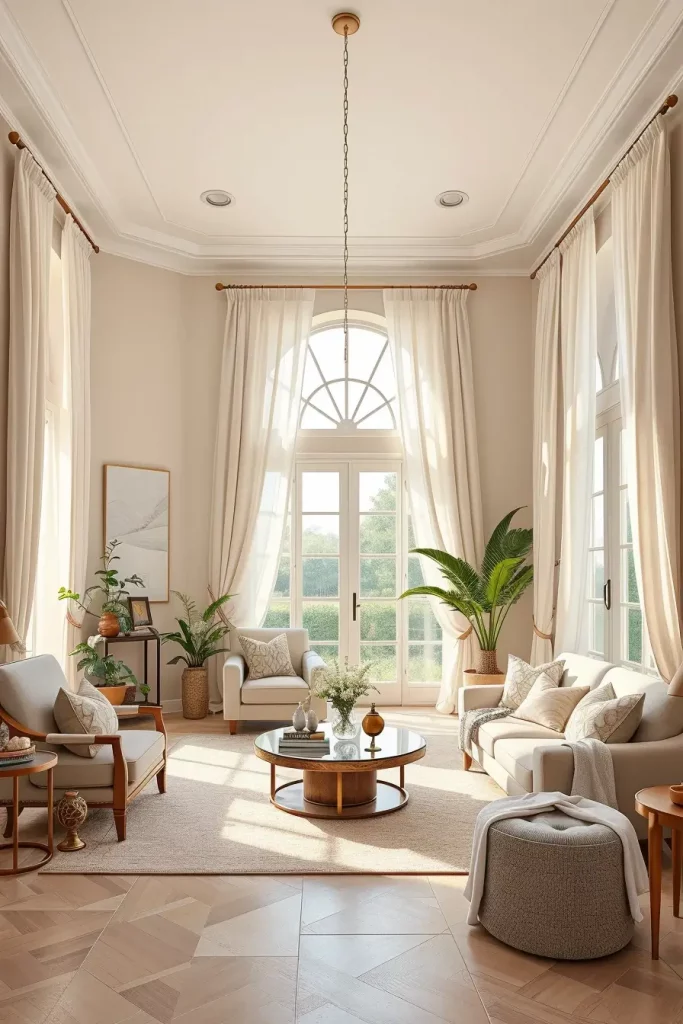
My design approach includes using drapery panels that reach from floor to ceiling which are mounted on wooden or wrought-iron rods. The room’s open feel remains unaltered through the application of elements which smooth its architectural lines. The use of linen brings both visual appeal and sound improvement while softening strong daylight.
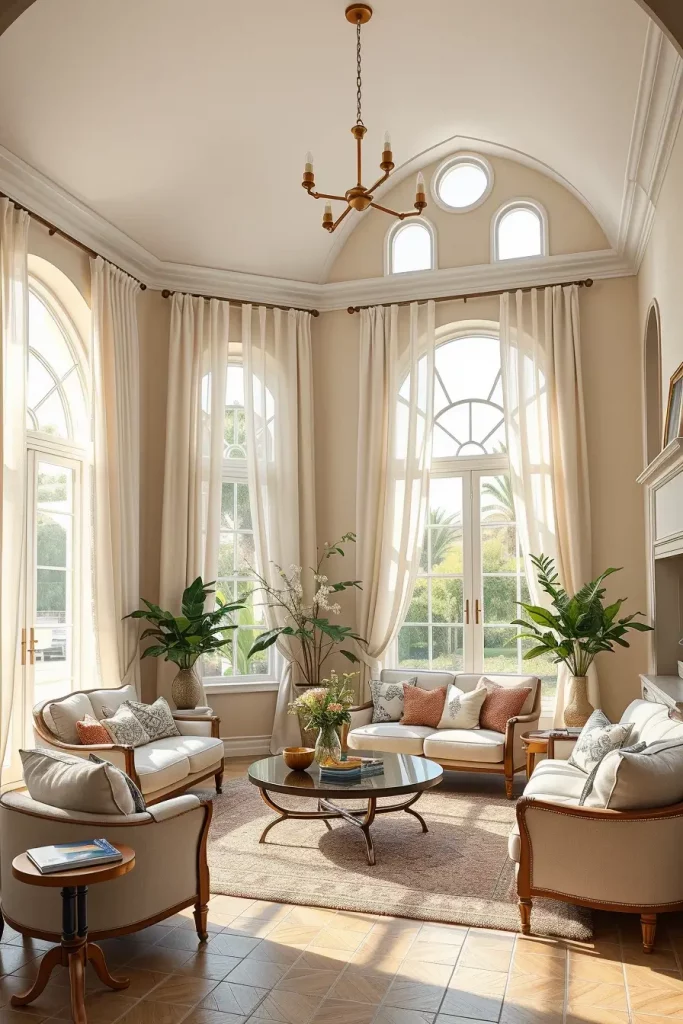
According to my observations the success of this element depends on its understated approach. The article from Better Homes & Gardens indicates that light linen curtains create an elegant and breezy atmosphere that combines beauty with comfort. No redesign is needed to lift a space because the right choice of curtains instantly transforms the room.
The completion of this element can be achieved by either using woven rope to tie back curtains or adding linen valances for refined elegance.
Large Windows To Maximize Natural Light
The influence of natural light remains fundamental to create the atmosphere in every Mediterranean living space. I strongly advise homeowners to install expansive windows or complete French doors to let sunlight enter every area of the room during daytime hours. Such window placement both deepens the space’s inviting feeling and lets textures including stucco and aged wood stand out. Natural light preserves the room’s fresh and expansive feeling together with its inviting character which forms the core elements of Mediterranean interior design.
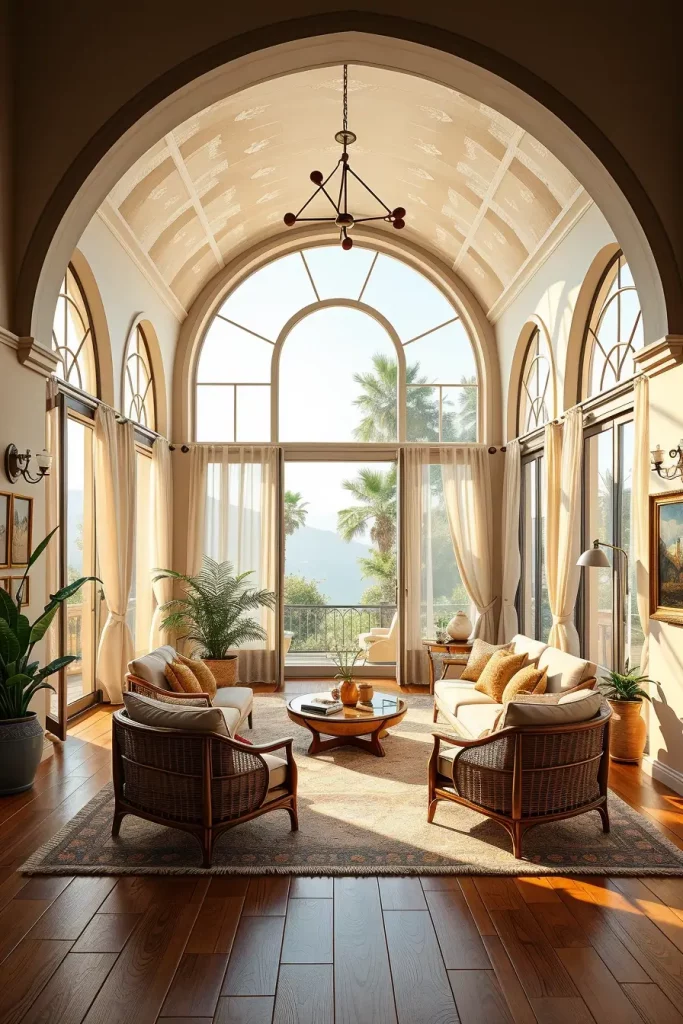
I structure my design plans starting from the window position by placing seating areas to view the outside view while optimizing natural light exposure. Black or bronze-framed windows serve as a tasteful accent while they make no claim to dominate the environment. The window treatment I prefer consists of sheer linen drapes which enable soft light transmission through the window opening. Such expansive glass units link home interiors with external views including seascapes or greenery in houses where they are installed.
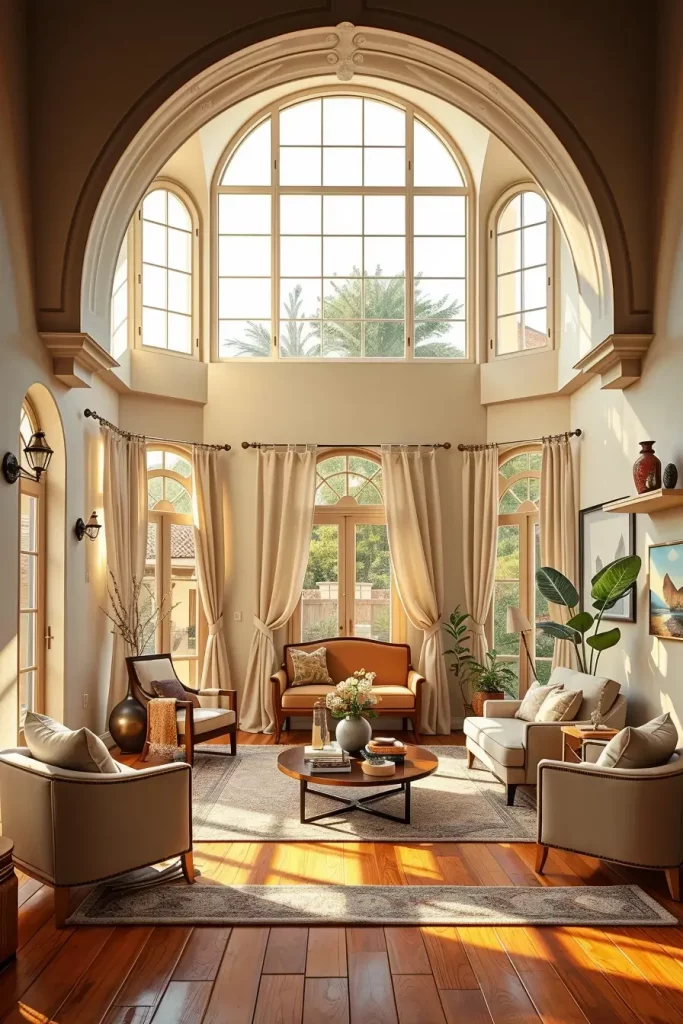
The presence of daylight in any space makes my smaller rooms appear larger according to my personal experience. The essential role of natural light in achieving Coastal Mediterranean breeziness for homes is explained thoroughly by experts from Architectural Digest magazine. The implementation of this simple yet powerful element stands as a top transformational addition to any space.
To enhance the space I would install indoor shutters or woven wood shades which give privacy while allowing sunlight to enter. The functional elements match perfectly with Mediterranean design principles.
Using Bold Rugs With Mediterranean Motifs
The introduction of Mediterranean-patterned bold rugs serves as an effective way to bring warmth and personality into your Mediterranean-style living room area. The traditional designs of these rugs incorporate deep blues with burnt orange and gold and terracotta elements arranged in ornate or geometric patterns. The room becomes anchored with their help particularly when a space is large and open and needs visual delineation.
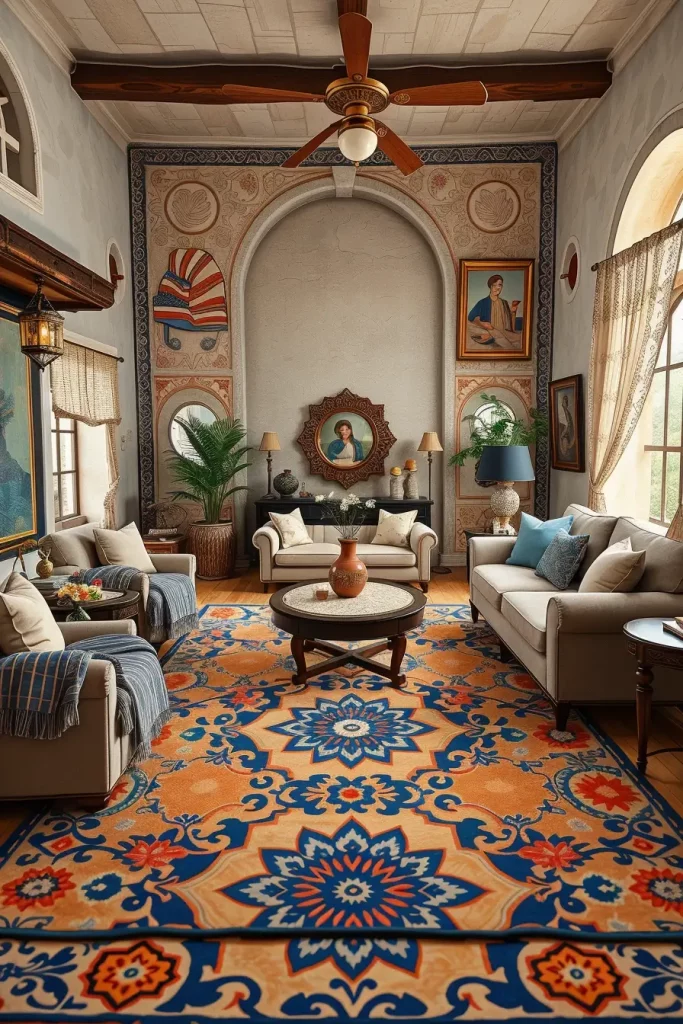
Flatweave and wool rugs with distressed finishes provide my preferred choice because they achieve the authentic appearance of handwoven antique pieces. Rugs function as both sofa foundations and table extenders and wall decorations. The complex designs of these rugs work well to complement basic furniture pieces and rough plaster surfaces. These rugs bring character to the design while staying faithful to the natural beauty of the style.
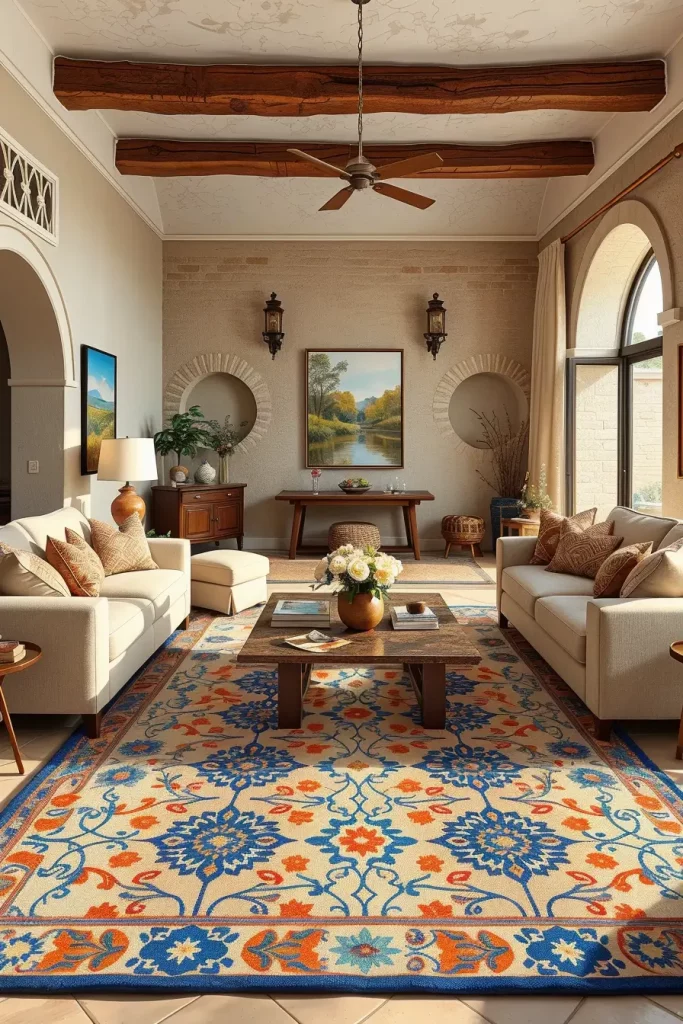
A Mediterranean room requires this element to be considered complete according to my perspective. House Beautiful highlighted that Mediterranean interior design uses ornamentation in a grounded manner and rugs serve as an excellent illustration of this principle. Bold design elements can be integrated through rugs which maintain tastefulness in their appearance.
The setup can be finished perfectly by adding throw pillows and upholstery with matching colors to create complete harmony.
Accent Pieces In Burnt Orange And Ochre
The Mediterranean design style stands out through its characteristic color scheme which includes burnt orange and ochre hues. The burnt orange and ochre tones appear regularly in my decorative items which include vases along with cushions and lampshades and wall art. These colors maintain the Mediterranean landscape’s sun-dried essence that deepens the appearance of neutral spaces.
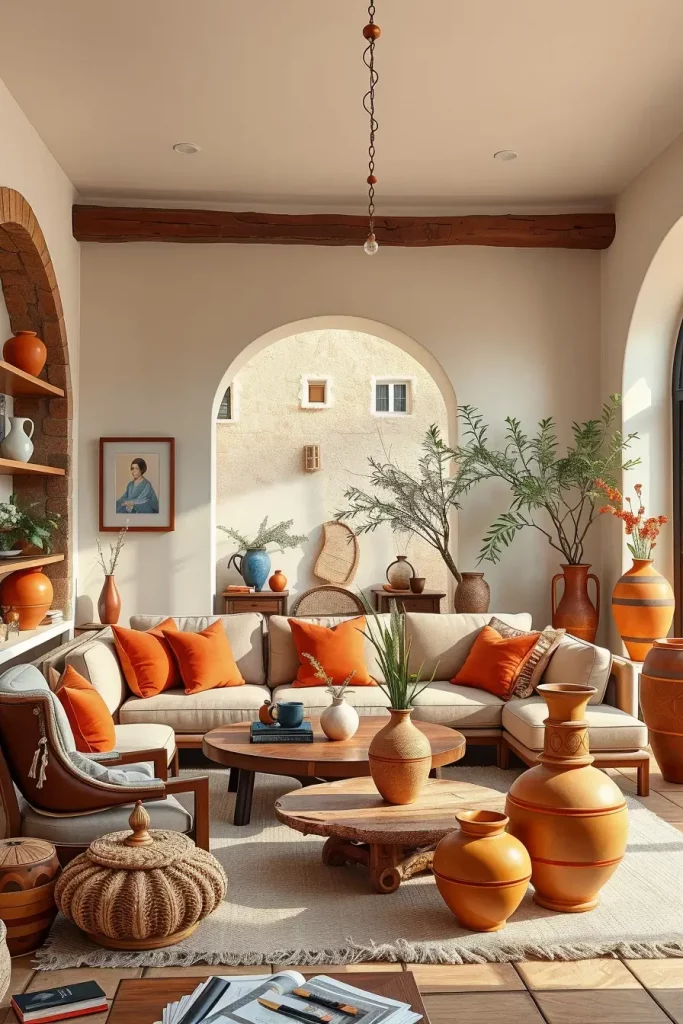
I maintain base room elements such as walls and sofas and curtains in white and cream tones when designing a space. The introduction of ochre and burnt orange colors appears in my designs through ceramics together with textiles and glass objects. Terracotta tiles together with rustic wood and wrought iron elements blend perfectly with these color shades which maintain the natural and historical essence of Mediterranean design.
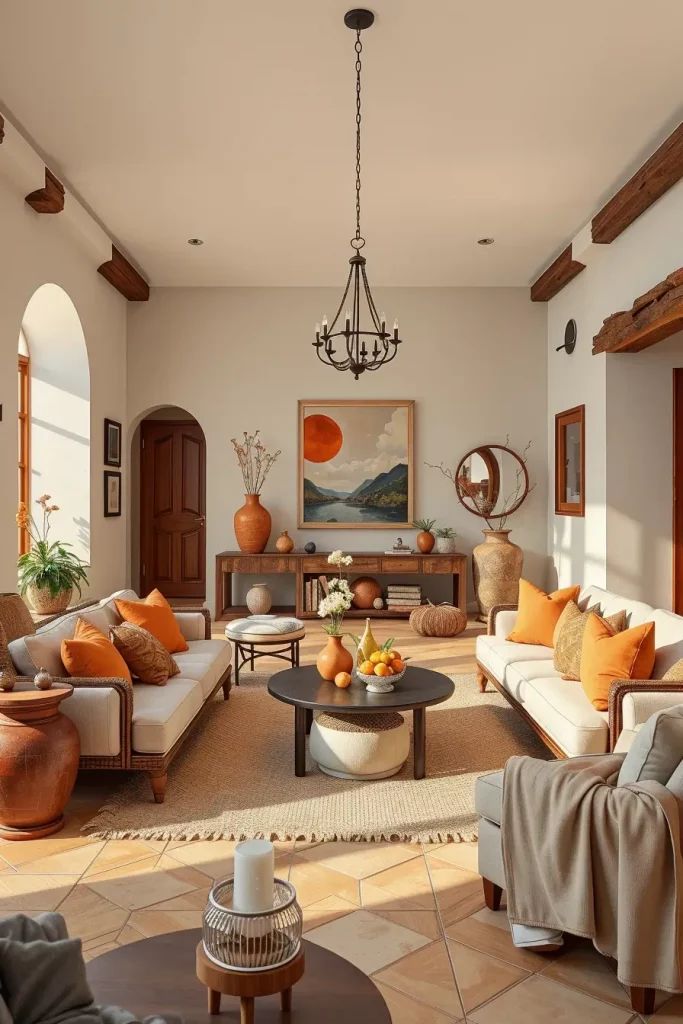
The color combination brings me a sense of stability. These colors create an atmosphere of hominess together with depth while preventing harsh sensory overload. Elle Decor proved through an article that using “sun-kissed tones” in Mediterranean design creates an ageless atmosphere of warmth. I follow that advice often.
This area would benefit from the addition of either a burnt-orange velvet ottoman or an ochre-upholstered armchair to strengthen the color design.
Incorporating Indoor Water Features
Designing a Mediterranean living room with an indoor water feature represents an advanced yet fulfilling design choice. The soothing sounds of water emerging from either fountains or wall-mounted devices constantly fascinates me because they create both serenity and spa-like ambiance in the space. The design element draws inspiration from Spanish and Italian and Greek courtyard architecture that integrates water as both decorative and functional.
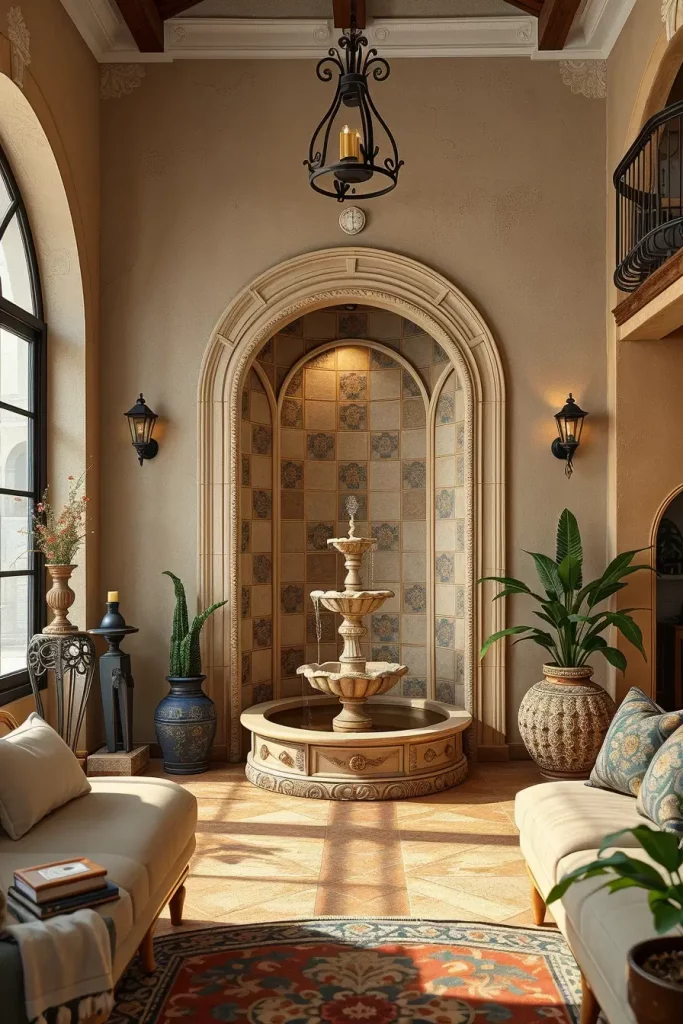
My preferred choice for indoor fountains includes compact ceramic and stone designs which merge with the room instead of becoming dominant. The placement of these items against a textured plaster wall or in a corner niche makes them create a delicate visual effect. Mosaic and terracotta designs work perfectly to keep the design theme consistent. Small residences can achieve a dynamic atmosphere through a small table-mounted water feature.
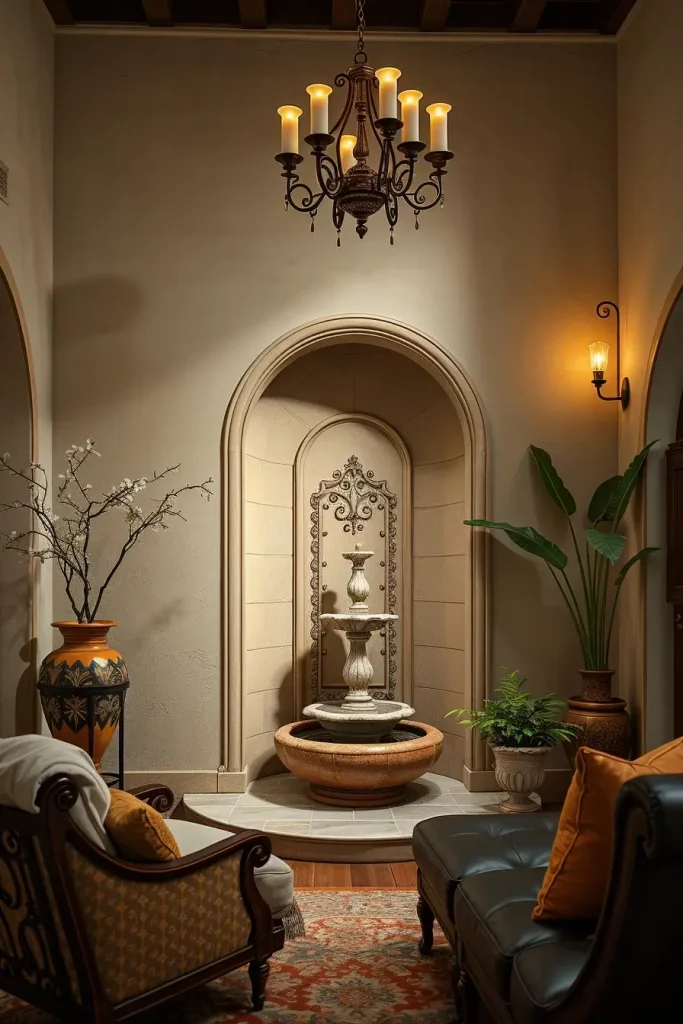
From my personal viewpoint the decorative aspect represents something greater than mere decoration because it creates an atmosphere. The Veranda magazine explains that Mediterranean interiors use water elements to create a perfect balance between warm and cool elegance which I have personally experienced. The space achieves a sense of completeness because this addition brings a tranquil touch.
To complete the look I would install soft uplighting or wall sconces with lantern designs which would illuminate the water surface.
Antique Elements With Old World Charm
Antique elements serve as an essential design element in Mediterranean interior design. My designs for Mediterranean spaces include selecting antique items which combine old world charm through their weathered wood furniture and iron candelabras as well as vintage pottery pieces that both tell stories and develop beautiful patinas. The selected pieces create permanent character while adding depth to the space.
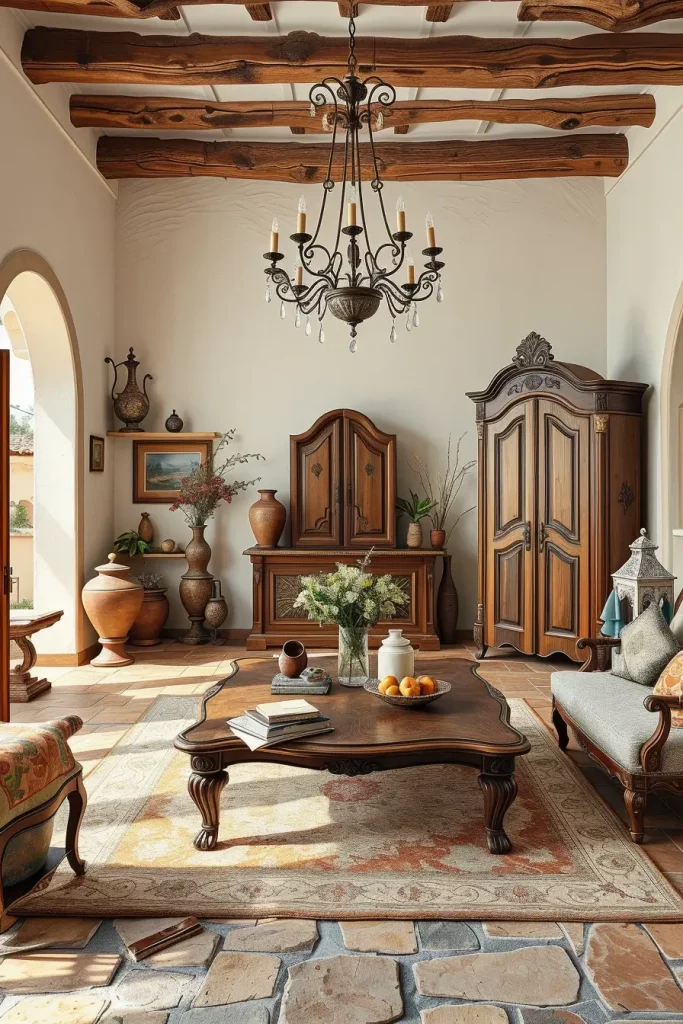
The practice of my design work includes using antique coffee tables with carved legs together with vintage armoires or distressed wooden shelves that serve as focal points while creating conversation areas. Modern spaces gain authenticity through decorative items that include aged brass trays and old maps and Mediterranean relics.

The rooms that appear most appealing have developed their character through years of accumulation rather than being fully decorated at once. Antiques serve an important purpose because they bring historical elements into modern newly constructed or renovated homes. Southern Living even describes Mediterranean decor as “an elegant interplay between the past and present.” I couldn’t agree more.
When constructing a new space begin with a couple of antique elements which you can pair with contemporary upholstery to achieve balance.
Mixing Textures With Clay, Stone, And Wood
The combination of clay stone and wood elements represents one of my preferred Mediterranean living room design approaches. Natural elements unite perfectly to establish a down-to-earth atmosphere which feels both luxurious and countryside at the same time. The elements maintain their individuality through these materials while maintaining a unified appearance.
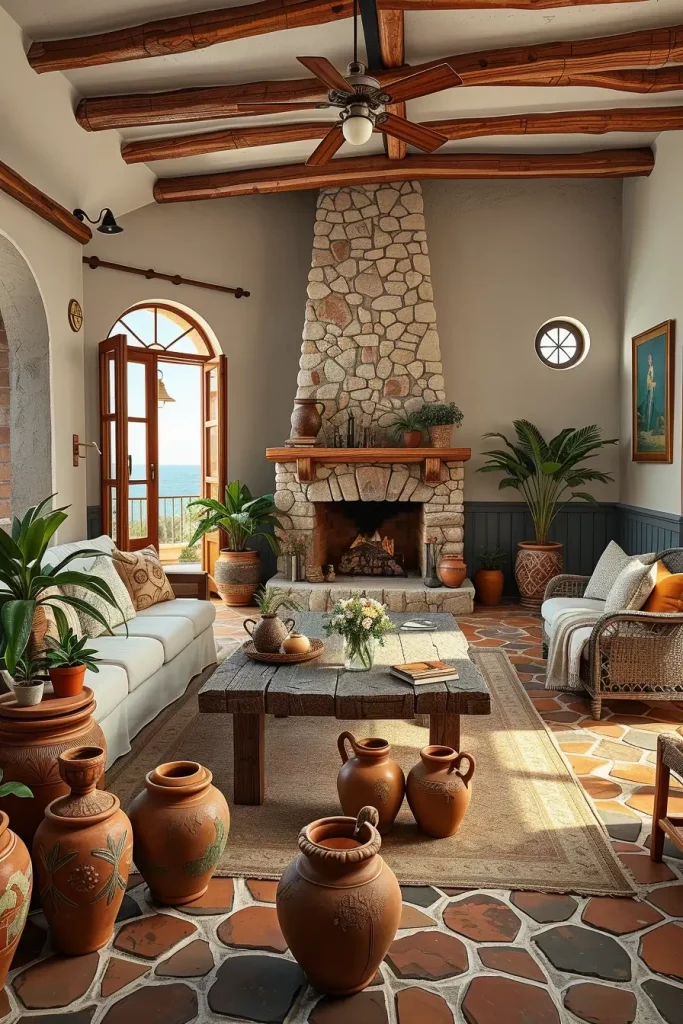
My design approach includes placing stone fireplaces with raw wood mantels and adding clay planters containing olive trees and a coffee table crafted from recycled timber. The flooring consists of terracotta tiles and wood-look ceramic materials to provide practical benefits. Multiple materials unite to represent the history of the region and deepen the natural alignment of this design style.
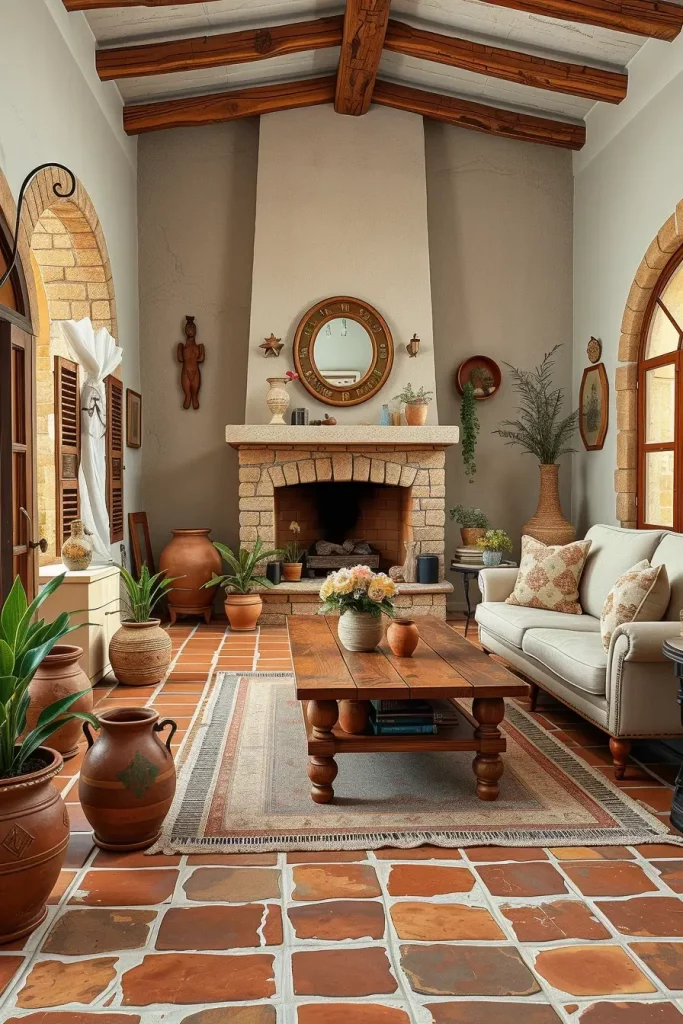
Through my design work I learned that mixtures of surfaces affect light differently thus creating both visual depth and eye-catching attributes in the space. The Better Homes & Gardens article explains that combining different textures within a neutral space creates depth without becoming overwhelming to the senses thus achieving successful Mediterranean design.
To make the space more comfortable you should introduce some soft contrasting elements such as woven blankets and linen-upholstered chairs.
Symmetry In Mediterranean Living Room Layouts
The essential element of Mediterranean interior layouts is symmetry that provides everlasting structure and balanced design. During Mediterranean living room design I place furniture symmetrically while matching wall art and light fixtures in pairs. The method helps create the harmonious character that Mediterranean living philosophy promotes.
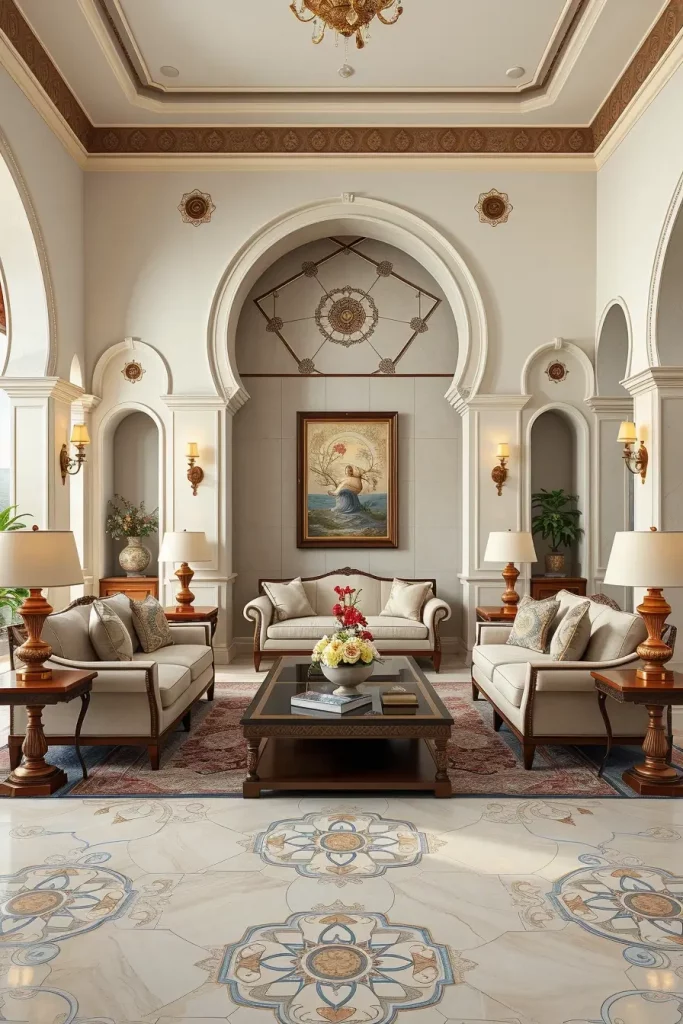
A standard Mediterranean living room design consists of two identical seating arrangements positioned across from each other with symmetrical end tables and lamps on either side of a central table. I install symmetrical arched niches that face each other when enough space exists next to the fireplace or main wall. Decor elements such as paired urns and framed art should duplicate each other to strengthen the visual rhythm.
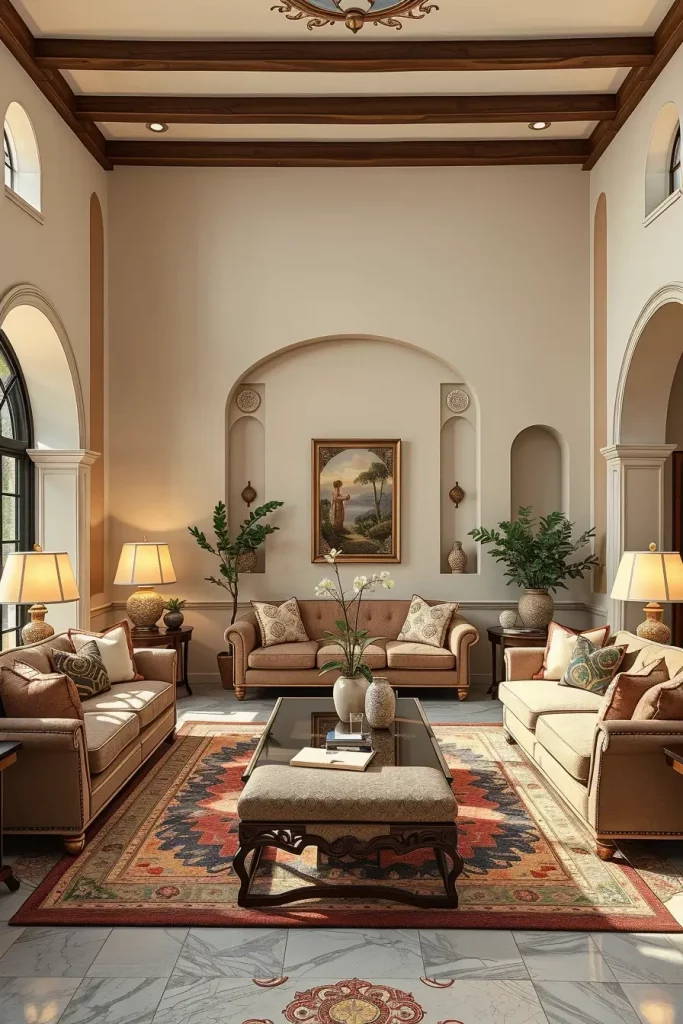
Symmetrical room arrangements provide both visual attractiveness and mental relaxation according to my perspective. The architectural publication Architectural Digest supports this method because symmetrical interior design creates flow and balance which are fundamental elements in Mediterranean spaces.
To achieve vertical symmetry and dramatic impact you should install pendant lights or chandeliers that match each other in seating areas.
Seaside-Inspired Mediterranean Accessories
The introduction of seaside accessories creates a small coastal feel within Mediterranean interiors that represents southern European serenity. Anyone trying this should begin with pale earthy base colors such as white and beige along with soft blue tones before adding sea-related accessories like coral sculptures, ceramic vases and sea glass elements. The Mediterranean style elements in these accessories preserve their essence through their unobtrusive and soft appearance. Lesbian and driftwood together with rope textiles create an uninhibited coastal atmosphere that describes Mediterranean beach living.
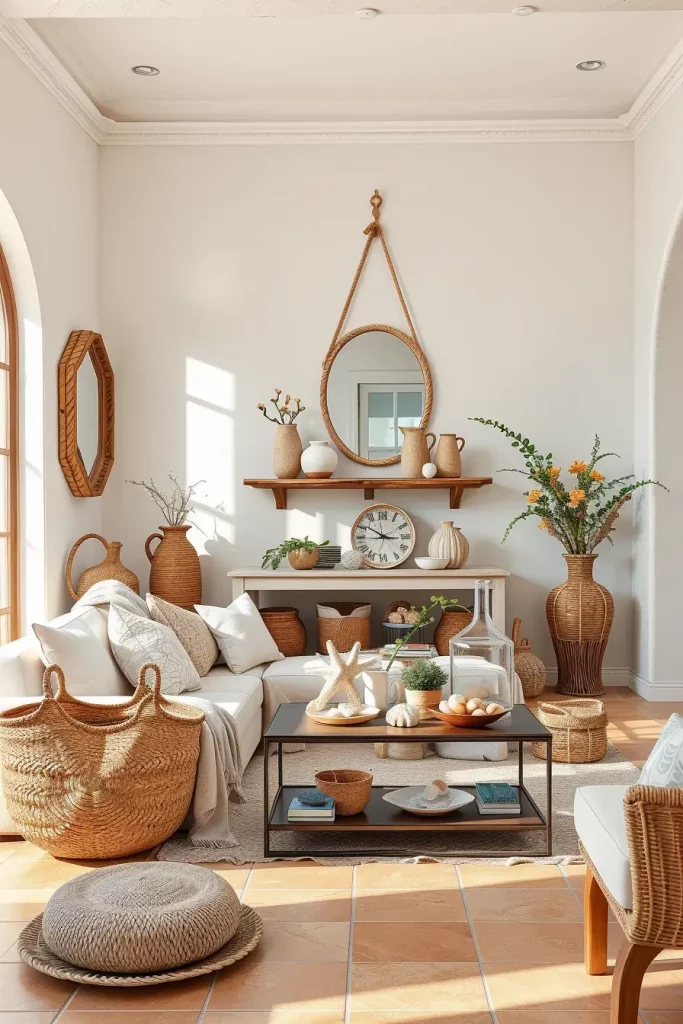
The essential components for Mediterranean style include woven baskets and ceramic jugs together with hand-painted tiles. Open shelving and consoles benefit from the placement of textured pottery to create warmth and heritage in the room. The nautical rope mirrors combined with seashell-filled lanterns serve as fashionable pieces which convey maritime stories. I choose decorative items that mention the sea without domination so the space stays Mediterranean-themed instead of becoming excessive beach-themed.
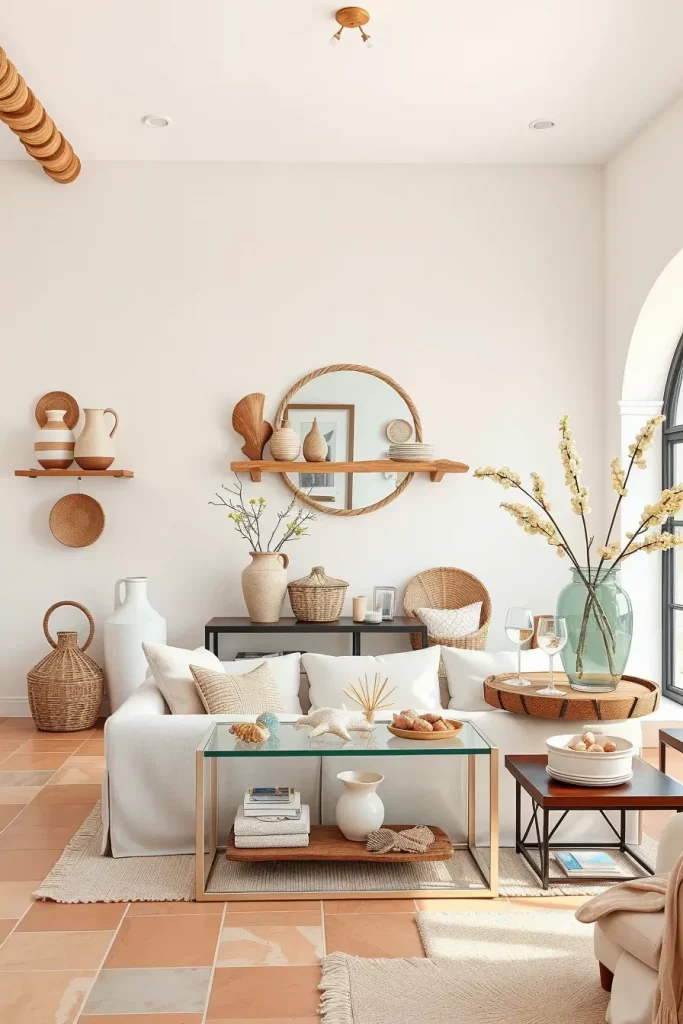
The terracotta urns together with vintage maritime prints delighted my Santa Barbara client. The coastal elements transformed their house in the interior into a seaside retreat. Elle Décor explains that the top principle behind this coastal style can be achieved with layered sea-inspired decorations inside muted color palettes.
The section would benefit from incorporating live Mediterranean plants including olive trees and rosemary which should be displayed in terracotta containers. The accessories receive additional enhancement from these elements which simultaneously add color and life to the complete Mediterranean living room design.
Curved Furniture For A Softer Silhouette
The distinctive characteristic of Mediterranean interiors includes curved furniture which produces gentle welcoming shapes that reduce the harshness of space. The visual flow of my designs depends on rounded sofas combined with barrel chairs and arch-backed benches. Open floor plans benefit from this functional design approach because straight lines tend to dominate such spaces. The use of curved forms promotes room movement along with architectural elements that appear in Mediterranean houses such as arches and domes.
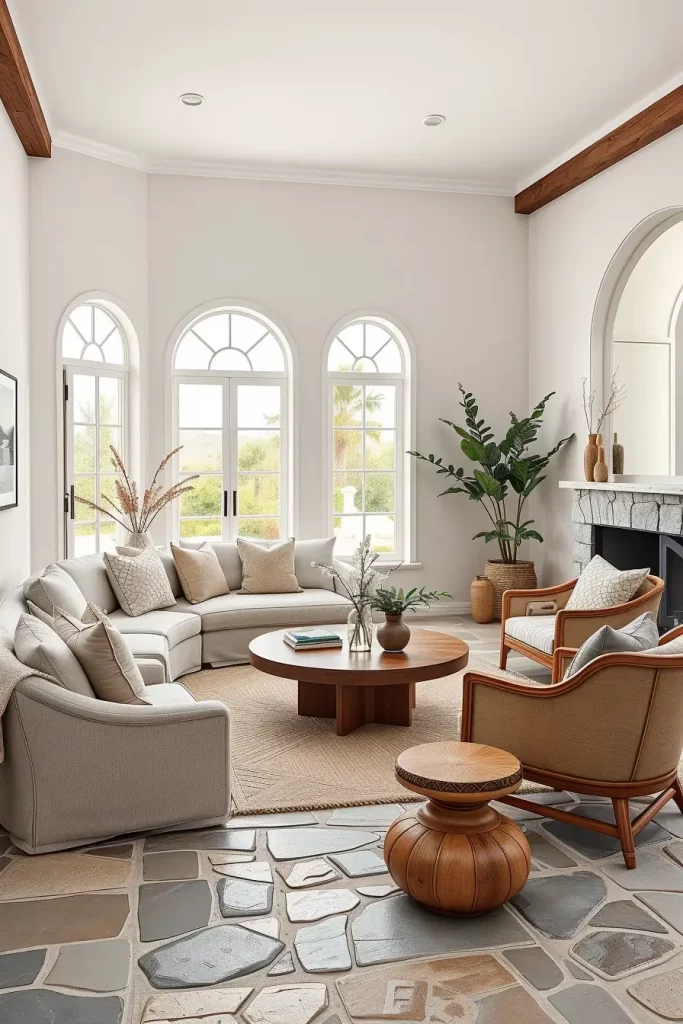
The design of this look relies on furniture upholstery made from cotton, linen and leather materials in natural and earthy fabric choices. The ivory or sand boucle curved sofa creates a beautiful visual effect. The seating area receives its balance from low-profile rounded coffee tables constructed from aged wood or stone. The rounded armchairs can receive Mediterranean-themed finishing with pillows that feature embroidery or tassels. The individual pieces remain self-contained within this style but they unite together to form a well-organized room design.
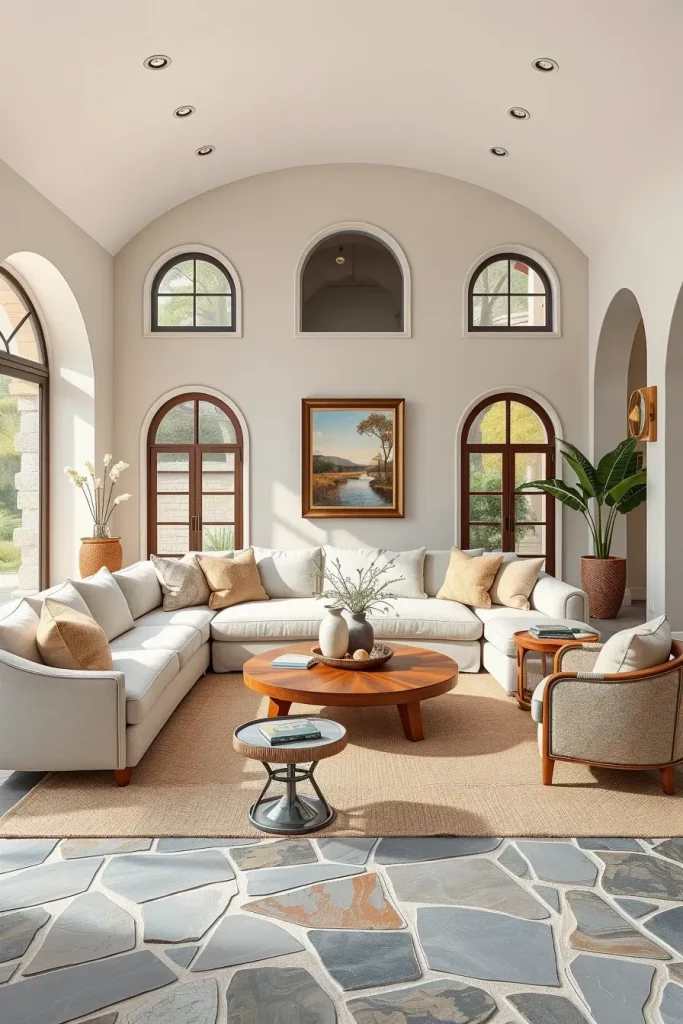
A main benefit of rounded furniture works well for compact living rooms because it distributes space effectively while preventing the area from appearing boxed-in. Architectural Digest recommends employing curved shapes to develop an organic environment that suits homes based on Southern European design.
The section could benefit from wall features including arched niches or curved shelving if there is anything missing. The delicate design elements create continuous curved lines which strengthen the Mediterranean design essence.
Blending Traditional And Contemporary Styles
It is my preferred method to keep the essence of Mediterranean living rooms by combining modern with traditional elements while achieving a contemporary fresh appearance. The beginning framework consists of traditional stucco walls and wooden beams and patterned tiles which I enhance with contemporary minimalist decorative fixtures and abstract art selections. The concept aims to protect original charm through the addition of functional elements which create contrast.
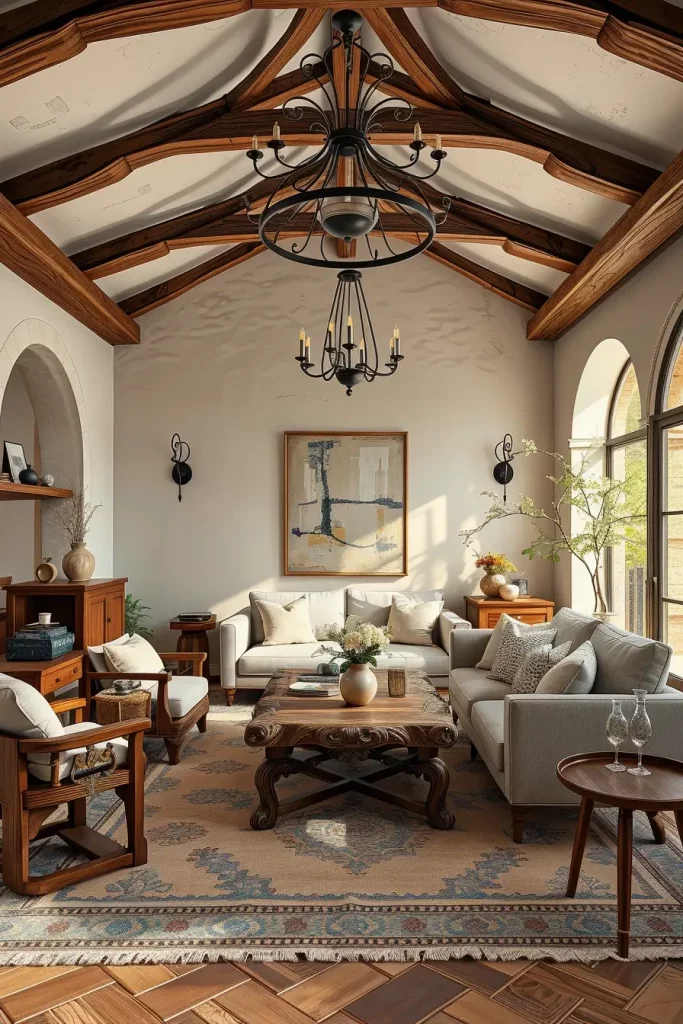
A carved wood coffee table with traditional elements creates a perfect match for contemporary linen sofas. The combination of metal floor lamps with stone fireplaces creates the perfect equilibrium in my design approach. Neutral color combinations that include terracotta and navy and ochre tones help establish equilibrium between original and contemporary elements.
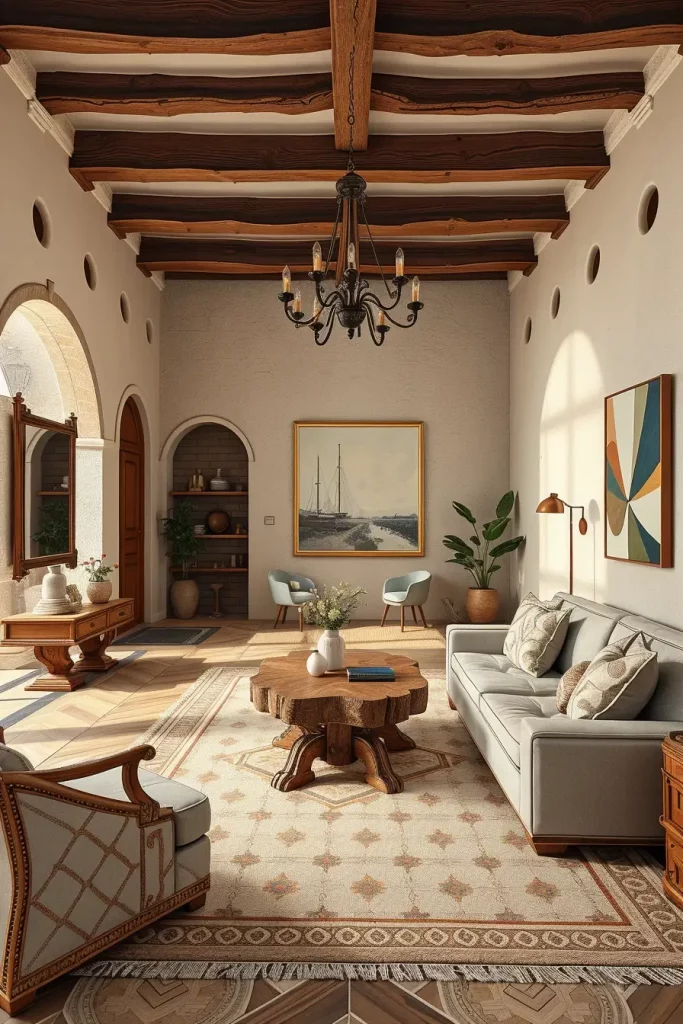
This combination appeals to me because it captures the Mediterranean home evolution process which honors cultural heritage through adaptive contemporary changes. According to Design Milk this modern style enables homeowners to combine eternal values with modern meaning.
The section would achieve better completeness through the addition of automated lighting features and interchangeable decor components that integrate into the shelves. The ability to adjust certain elements in a space creates traditional quarters that become adaptable to contemporary requirements.
Creating Indoor-Outdoor Mediterranean Living Spaces
Mediterranean living room design focuses on developing natural transitions between interior and exterior spaces. Through my work on many residences I have installed glass doors and wide arches together with full-length curtains which link the comfortable indoor lounge area to sunny courtyards and patios. The design arrangement optimizes both natural illumination and ventilation as well as emotional spatial openness.

The materials I choose for these living rooms include outdoor-friendly terracotta floors and stone fireplaces and teak or rattan or iron furniture. The visual connection between spaces occurs through large windows and folding doors that also let the indoor plants reflect the outdoor garden. When advising customers I recommend adding ceiling fans with sheer linen drapes that help improve ventilation and filter sunlight.
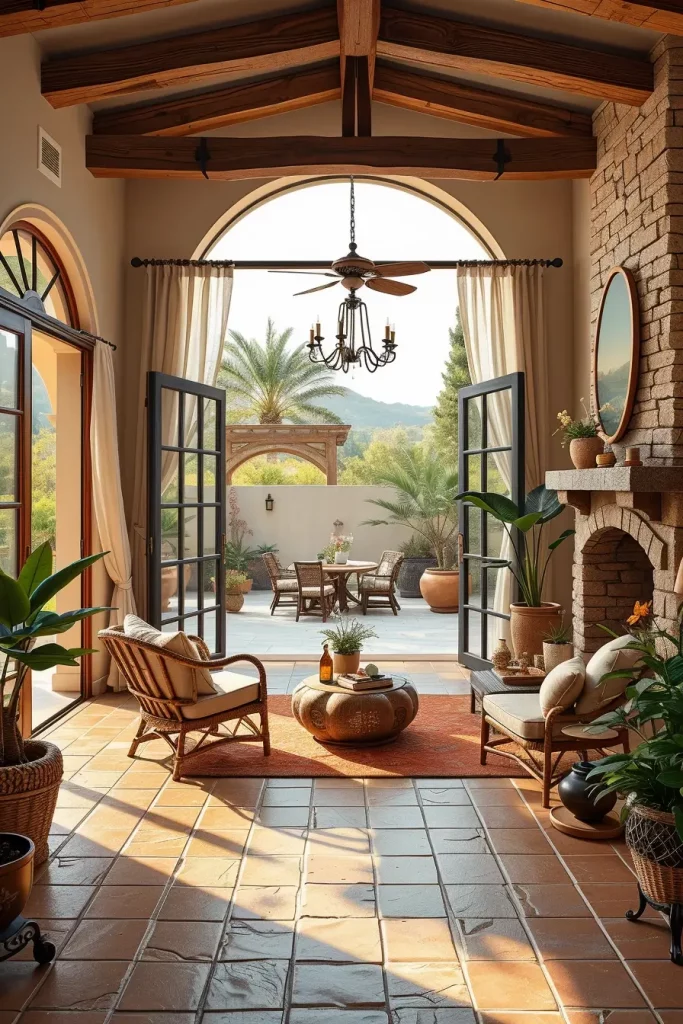
The method proves highly effective for warmer climate environments. The homeowner expressed that the added design made his Napa Valley home feel like he was always on vacation. The Veranda publication explains that integrating natural elements inside the home supports both physical well-being and relaxation thus matching the Mediterranean lifestyle principles.
To enhance this concept I would install a small indoor fountain or outdoor-style wall lamps in the living room area. External elements I would introduce would unite outdoor and indoor spaces while conserving their functionality.
